A Century of Polar Research
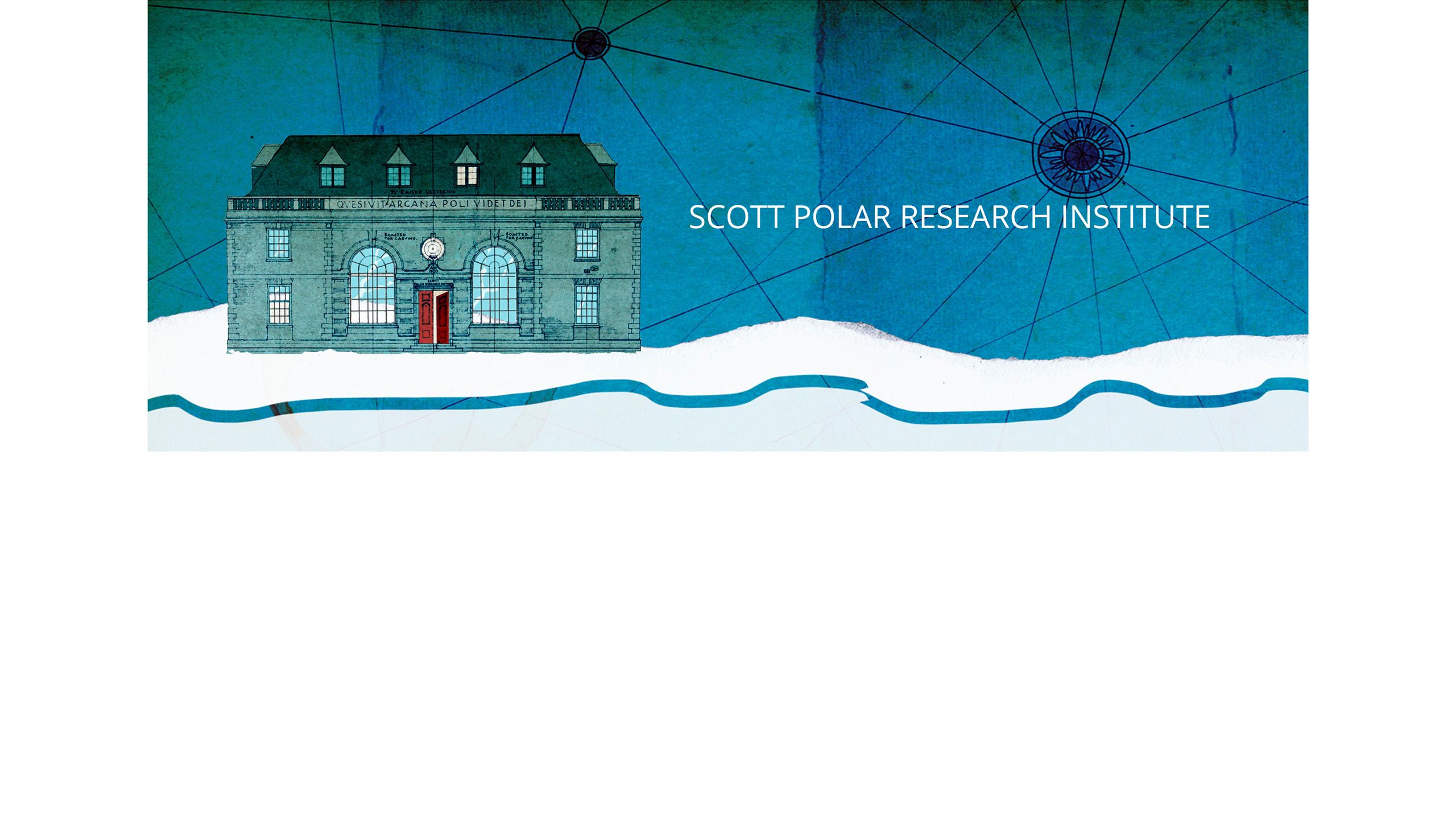
In 1912, geologist Frank Debenham had a grand idea.
On the side of an Antarctic volcano Frank Debenham had a grand idea. In 1912, Debenham and Raymond Priestley scaled Mount Erebus to conduct a geological survey during the British Antarctic Expedition 1910-13 (Terra Nova) led by Captain Robert Falcon Scott. Priestley had already studied the active volcano on an earlier expedition, but he was unsure where his notes from that time were being stored. Debenham realised that British polar explorers needed a headquarters – somewhere to share their findings and learn from each other.
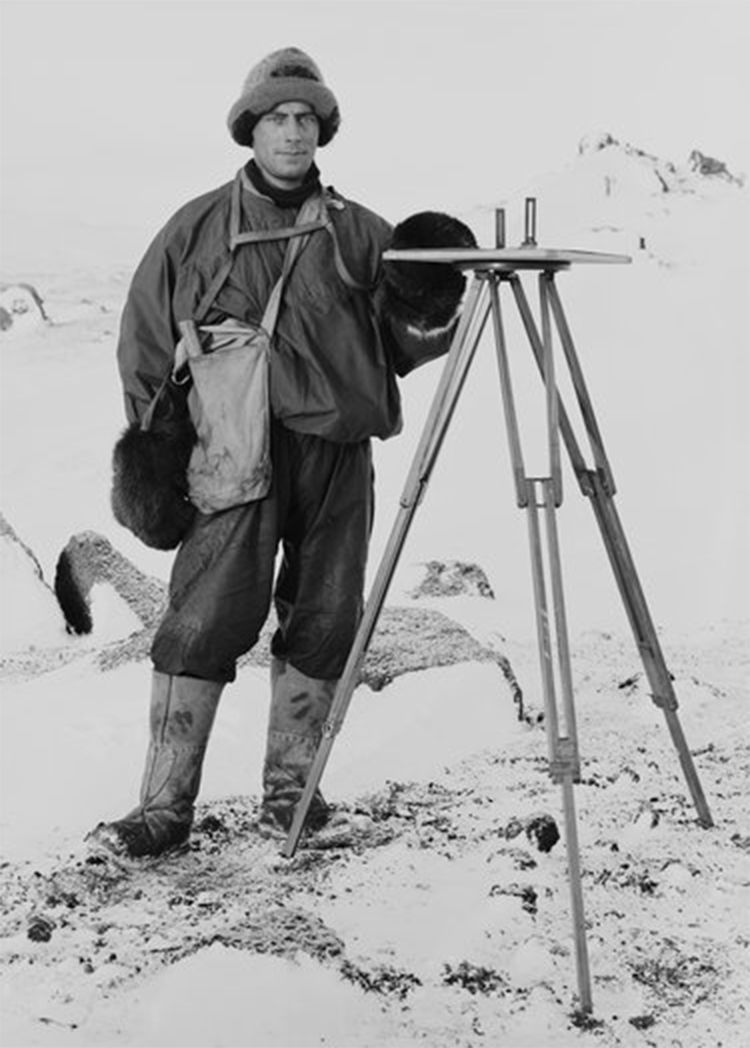
Frank Debenham in Antarctica with his plane table surveying equipment. Photographer: Herbert Ponting. SPRI Picture Library: P2005/5/482. Copyright: Scott Polar Research Institute, University of Cambridge
Frank Debenham in Antarctica with his plane table surveying equipment. Photographer: Herbert Ponting. SPRI Picture Library: P2005/5/482. Copyright: Scott Polar Research Institute, University of Cambridge
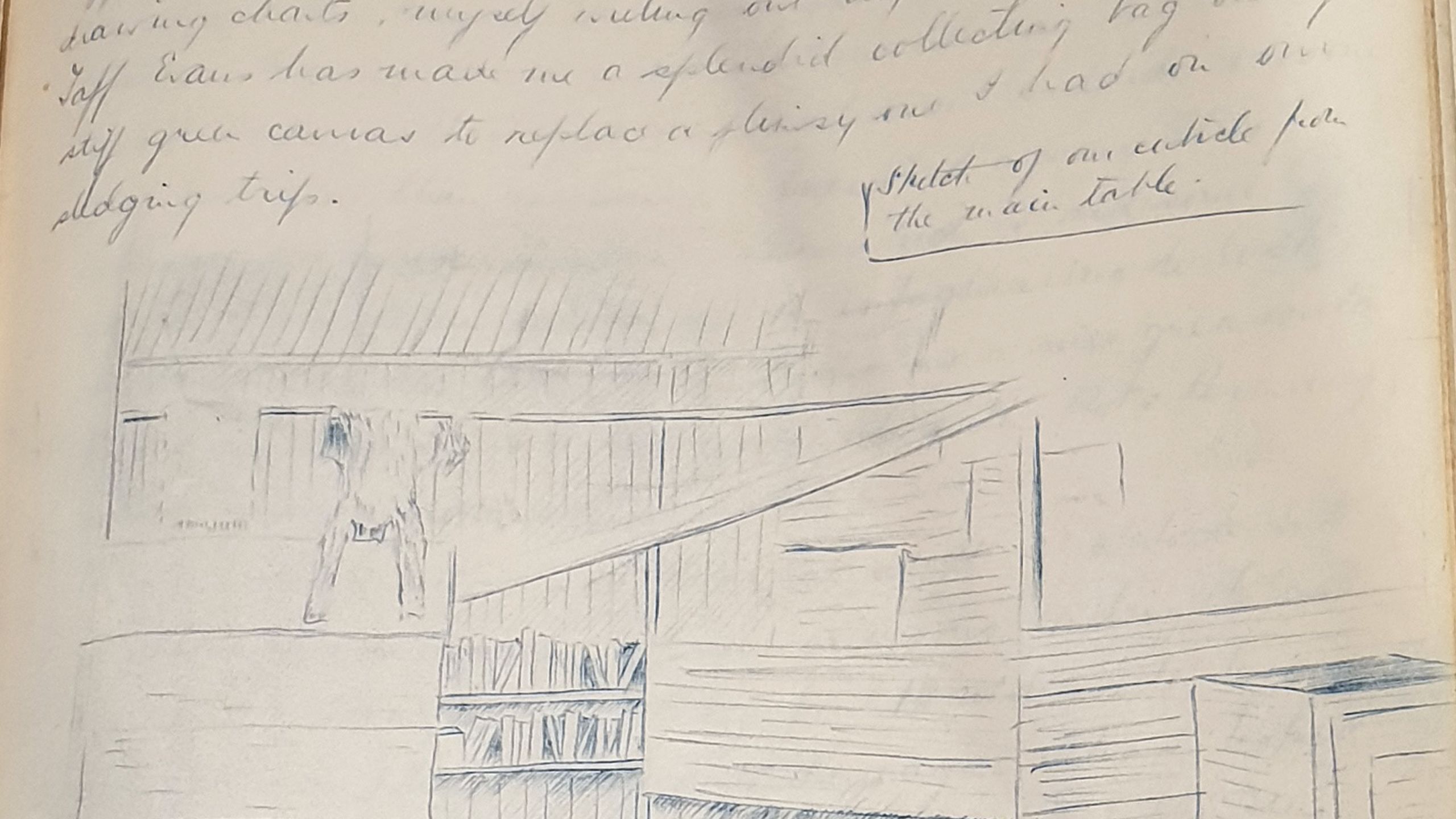
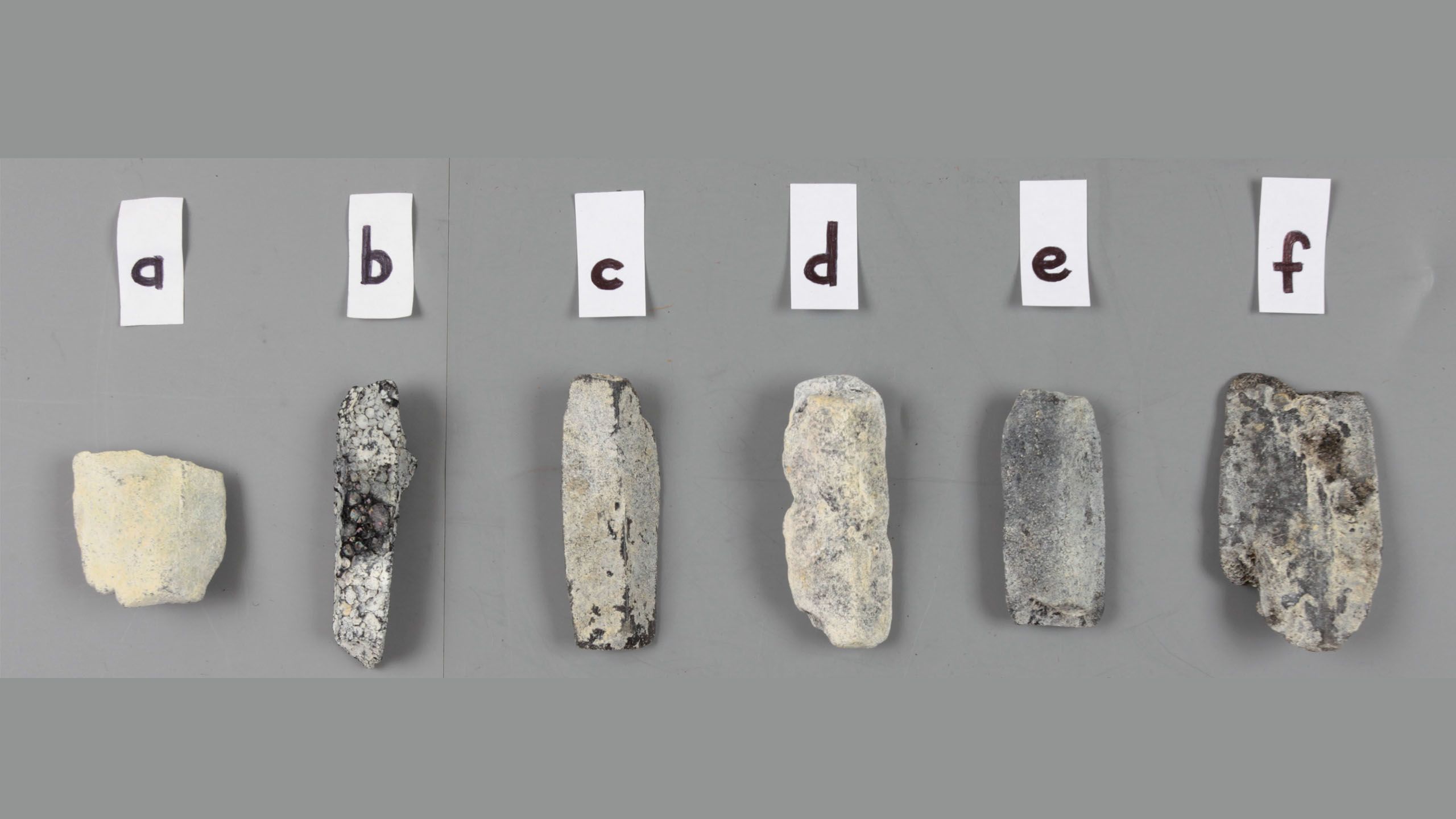
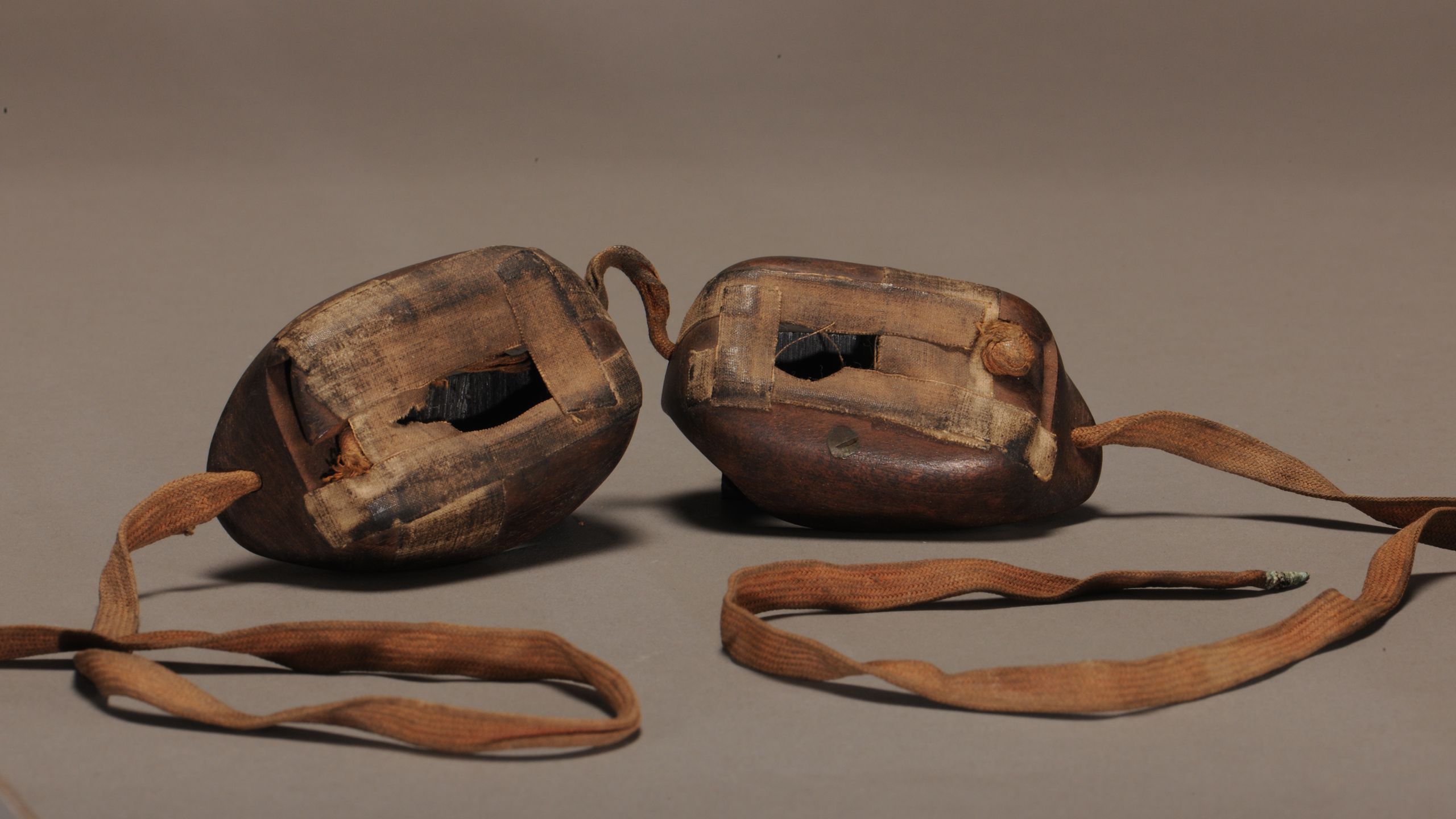

This is a detail from he diary Debenham was keeping when he first imagined a polar institute. He realised that the expedition scientists needed a headquarters to share their findings, collaborate, and progress human knowledge of the polar regions. The idea for the Scott Polar Research Institute was born. MS 279/3
This is a detail from he diary Debenham was keeping when he first imagined a polar institute. He realised that the expedition scientists needed a headquarters to share their findings, collaborate, and progress human knowledge of the polar regions. The idea for the Scott Polar Research Institute was born. MS 279/3

As well as a place for sharing ideas, polar scientists needed somewhere to study the specimens they collected in the field. Debenham collected these feldspar crystals from the crater of the active volcano Mount Erebus, where he first had the idea for a polar institute. Polar Museum: N: 782
As well as a place for sharing ideas, polar scientists needed somewhere to study the specimens they collected in the field. Debenham collected these feldspar crystals from the crater of the active volcano Mount Erebus, where he first had the idea for a polar institute. Polar Museum: N: 782

Scientific work in the Antarctic was very demanding physically. The men suffered from the powerful glare of the sun reflecting off the ice and snow. Without the right protection, this could cause extreme eye pain and temporary blindness known as ‘snow blindness’. Polar Museum: N:79
Scientific work in the Antarctic was very demanding physically. The men suffered from the powerful glare of the sun reflecting off the ice and snow. Without the right protection, this could cause extreme eye pain and temporary blindness known as ‘snow blindness’. Polar Museum: N:79
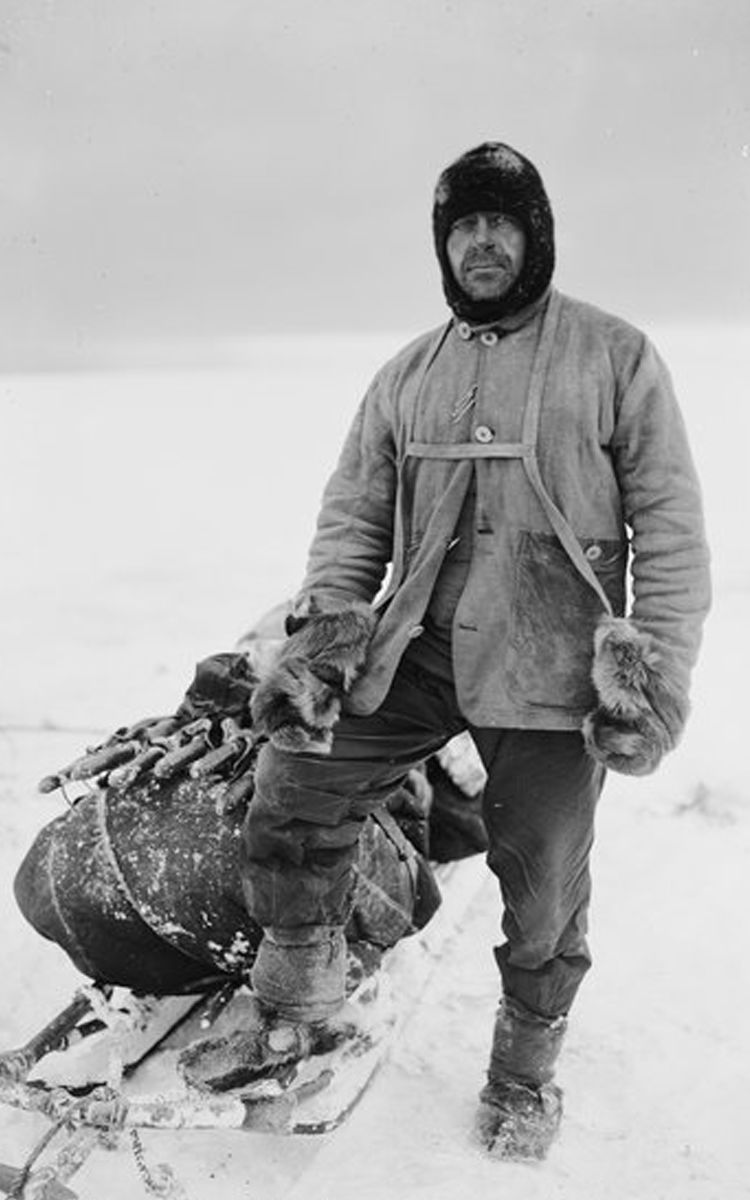
Captain Scott in his sledging gear. Copyright Scott Polar Research Institute, University of Cambridge. P2005/5/370
Captain Scott in his sledging gear. Copyright Scott Polar Research Institute, University of Cambridge. P2005/5/370
As Deb, as he known to his friends, was studying his surroundings, Captain Scott was leading a small party of men to the South Pole.
This wasn't Scott's first attempt on the Pole. He had previous experience, which is why the unusually bad weather that hampered their journey took him and his party by surprise. Nevertheless, they pressed on, eager to achieve an important expedition goal. All the while they knew that the Norwegian explorer Roald Amundsen had also arrived in Antarctica and was making his own bid to be first to reach the South Pole. As they travelled, they continued with their scientific goals, collecting rocks and fossils and documenting the landscape and weather they encountered.
On 17 January 1912, exhausted after a long march, Scott's party reached their destination. To their dismay they discovered that Roald Amundsen's party had got there first.
Edward Adrian Wilson, Robert Falcon Scott, Lawrence Oates, Henry Robertson Bowers and Edgar Evans were sorely disappointed to find that their goal had already been achieved.
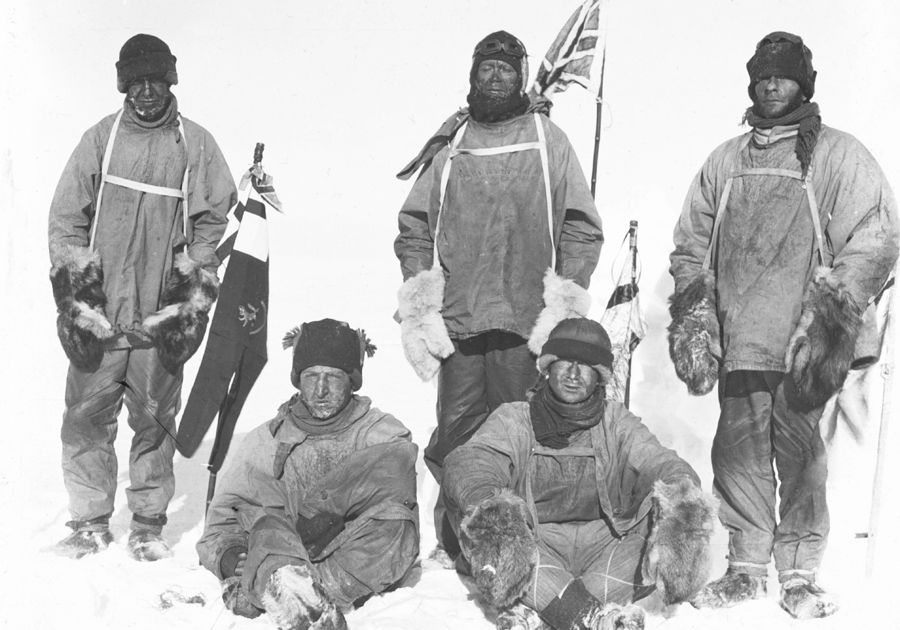
The Southern Party at the South Pole. Copyright Scott Polar Research Institute, University of Cambridge. P2005/5/1346
The Southern Party at the South Pole. Copyright Scott Polar Research Institute, University of Cambridge. P2005/5/1346
They set off on the long march north, back to the warmth, comfort and companionship of their main camp at Cape Evans, more than 800 miles away.
On their return journey tragedy struck.
On 17 February 1912 Petty Officer Edgar Evans collapsed and died. He had been suffering from severe frostbite, and had fallen and injured his head.
On 16 March 1912 Captain Lawrence Oates voluntarily left the shelter of the tent and walked to his death. He had been suffering from terrible frostbite, and despite the protestations of his colleagues he knew he was slowing the party's progress dangerously.
Captain Robert Falcon Scott, Dr Edward Adrian Wilson and Lieutenant Henry Robertson Bowers marched on, but on 20 March 1912 they were stopped in their tracks by a dreadful blizzard. On 29 March 1912 Captain Scott wrote his last diary entry.
Every day we have been ready to start for our depot 11 miles away, but outside the door of the tent it remains a scene of whirling drift. I do not think we can hope for any better things now. We shall stick it out to the end, but we are getting weaker, of course, and the end cannot be far. It seems a pity but I do not think I can write more. R. Scott. Last entry.
For God's sake look after our people.
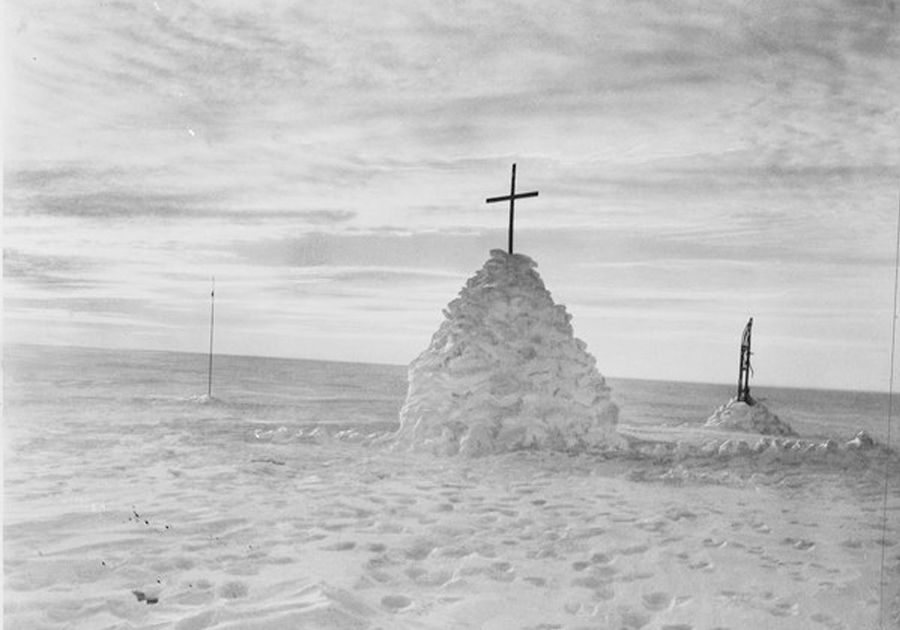
A snow cairn with cross on top in foreground encases the tent in which Scott, Bowers and Wilson died. Copyright Scott Polar Research Institute, University of Cambridge. P2005/5/1249
A snow cairn with cross on top in foreground encases the tent in which Scott, Bowers and Wilson died. Copyright Scott Polar Research Institute, University of Cambridge. P2005/5/1249
When the news of the loss of Scott's party reached home there was an enormous outpouring of grief. The Mansion House Scott Memorial Fund raised money towards supporting the families of the men who were lost, publishing the scientific data gathered on the expedition and, in November 1920, founding the Scott Polar Research Institute as the national memorial to Captain Scott and his men.
The building would contain these at least; a practical museum of Polar equipment... the things explorers want to see and handle and know the use and cost of, such as camp gear, instruments, clothing etc.; a comprehensive library of Polar literature and maps... thirdly a set of rooms for the use of people undertaking research, these people might be returned scientists, budding explorers or people working up papers on Polar subjects who require the facilities.
Frank Debenham was the driving force behind the founding of the Scott Polar Research Institute. His vision, as outlined above, was for a place that brought together polar researchers and resources for the betterment of polar expeditions and scientific investigation.
Debenham and several of the other scientists from Captain Scott's Terra Nova expedition had found themselves in Cambridge writing up results, so it made a good location to establish the new Institute. Although the University formally approved the new Institute on 26 November 1920, it would be another 14 years before a dedicated building was erected.
The Institute's dedicated building, designed by renowned architect Herbert Baker, opened in 1934 - and not a moment too soon. In 1925 the University Reporter noted that the geological specimens, expedition gear, books and other items for the new institute's collection that were accumulating meant that ‘some accommodation will be required at once, as material, weighing about 2½ tons, has already arrived.’
The role of the Institute as a national memorial is evident today in some of the design features within the building. A niche above the entrance on Lensfield Road houses a bust of Captain Scott, cast from a sculpture by Scott's widow, Kathleen, an established artist in her own right. Inside the entrance, the ceiling of the ‘memorial hall’ features two impressive painted maps of the Arctic and Antarctic, complete with the names of explorers and their ships, while penguins and polar bears perch on top of columns and a starry floor-mosaic shows the Northern Hemisphere’s Ursa Major constellation alongside the Southern Cross.
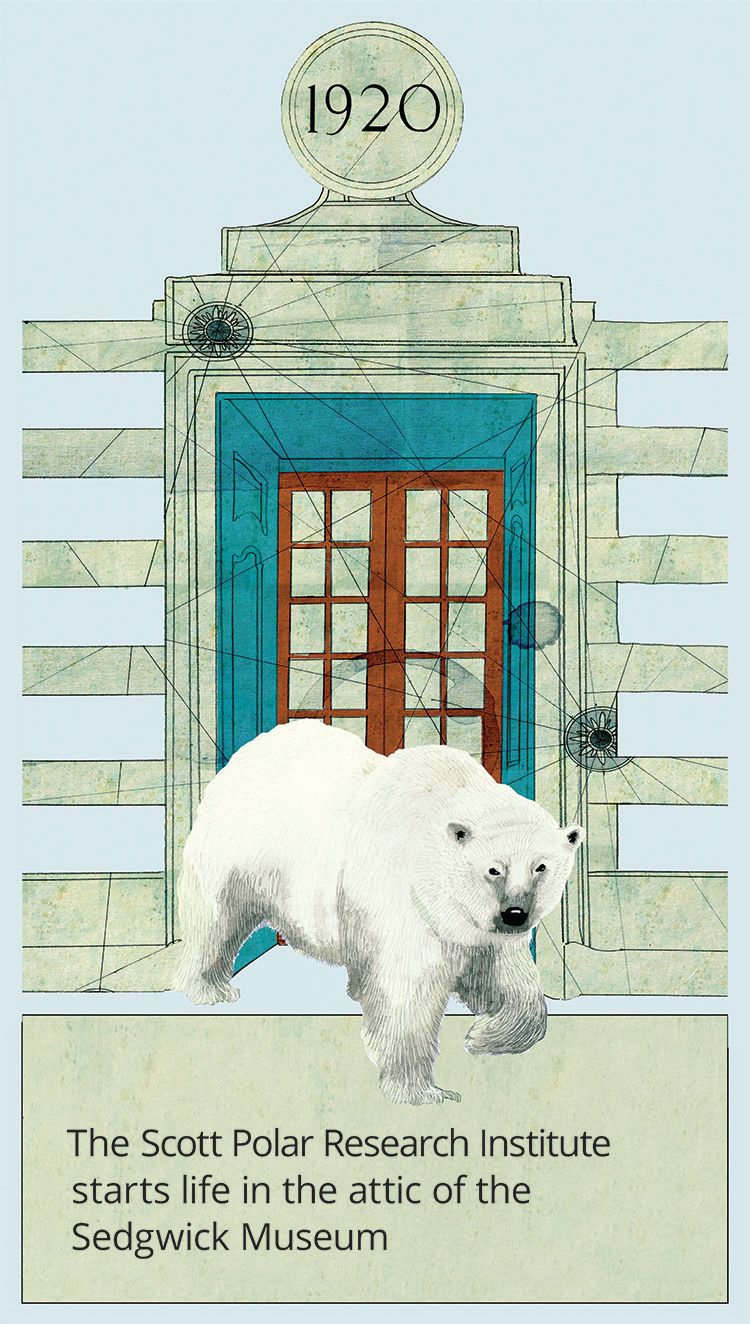
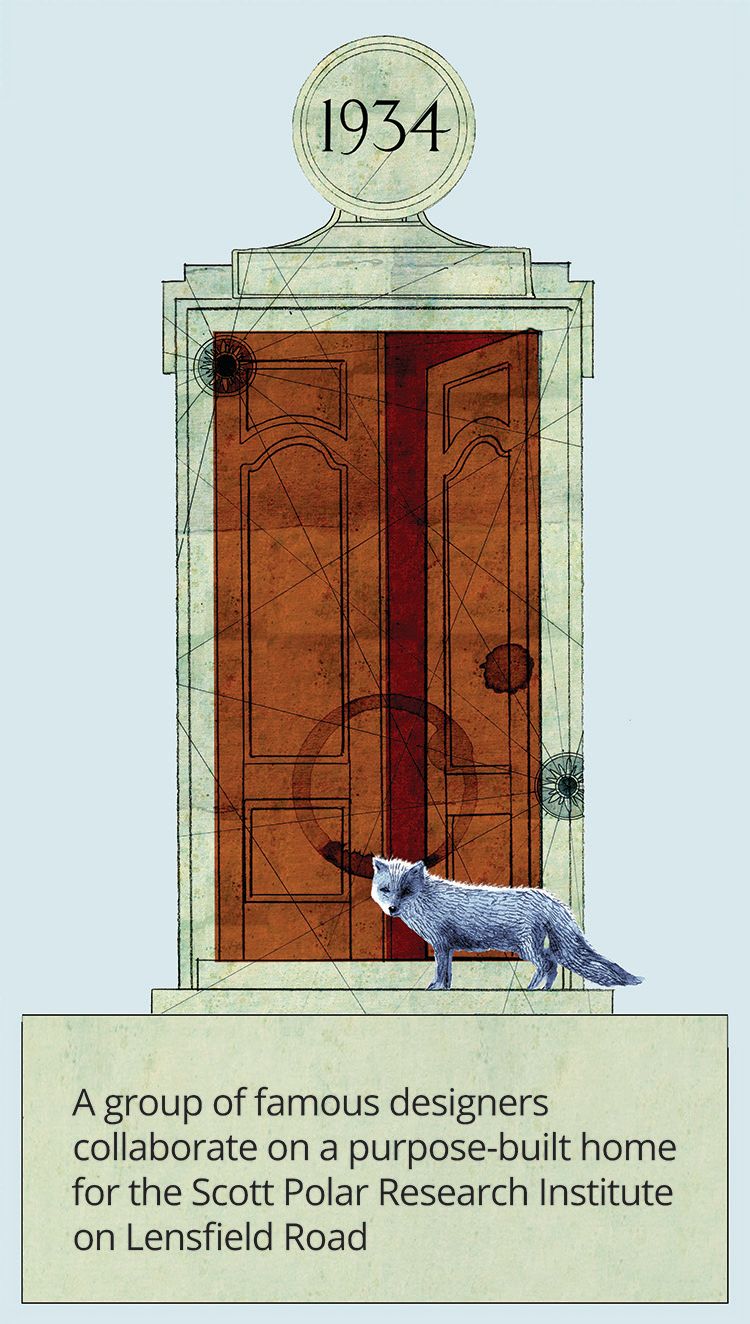
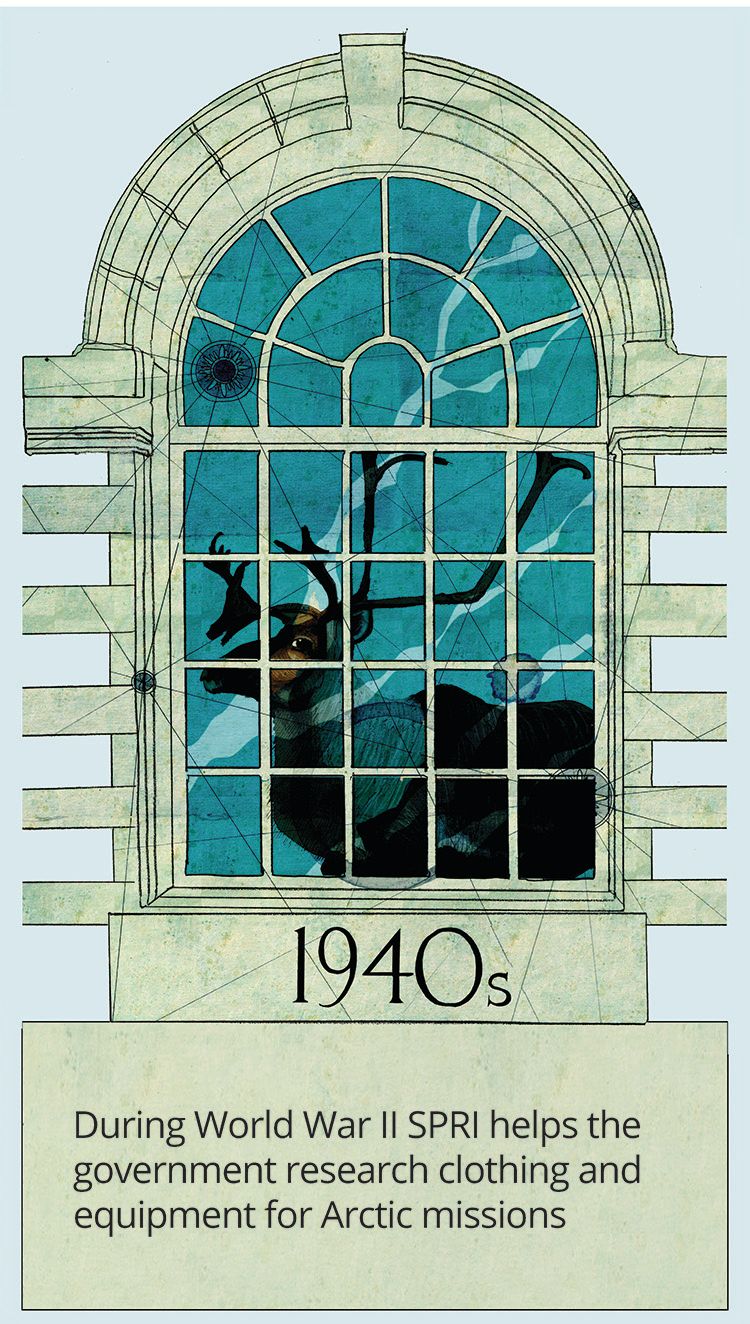
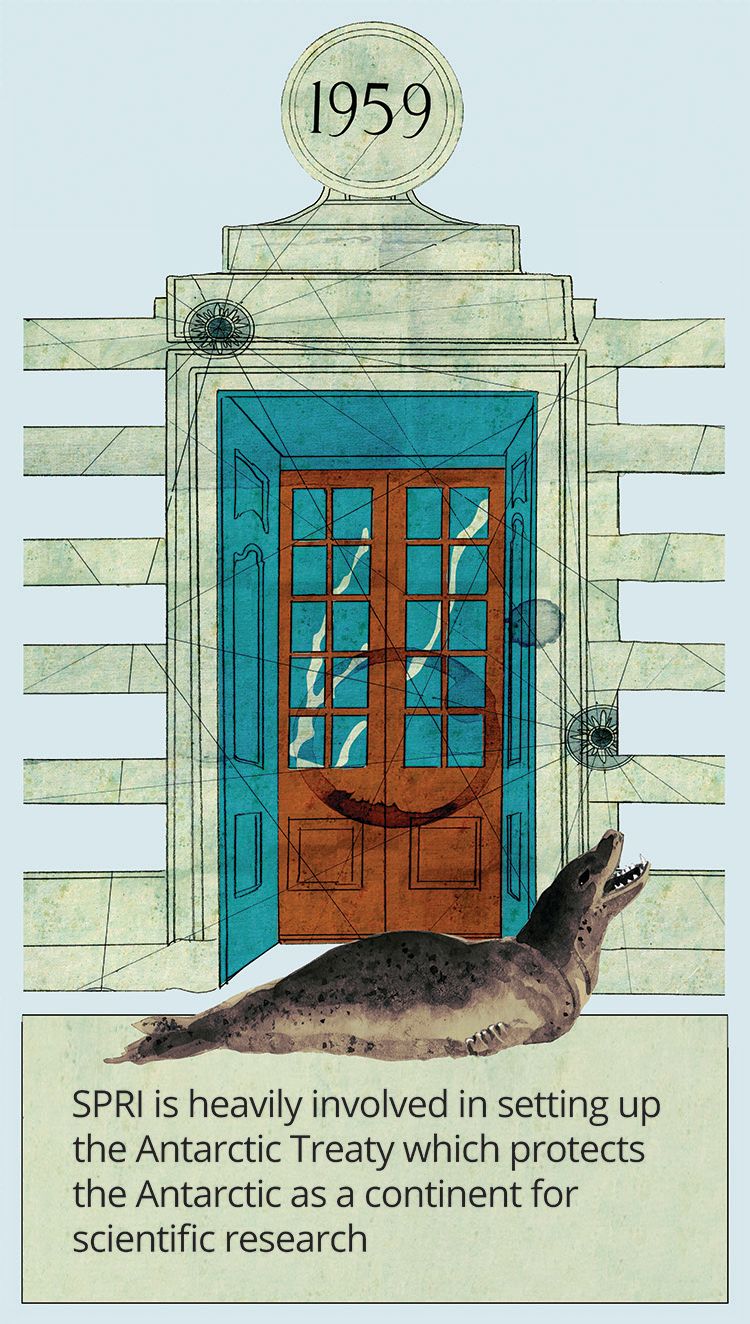
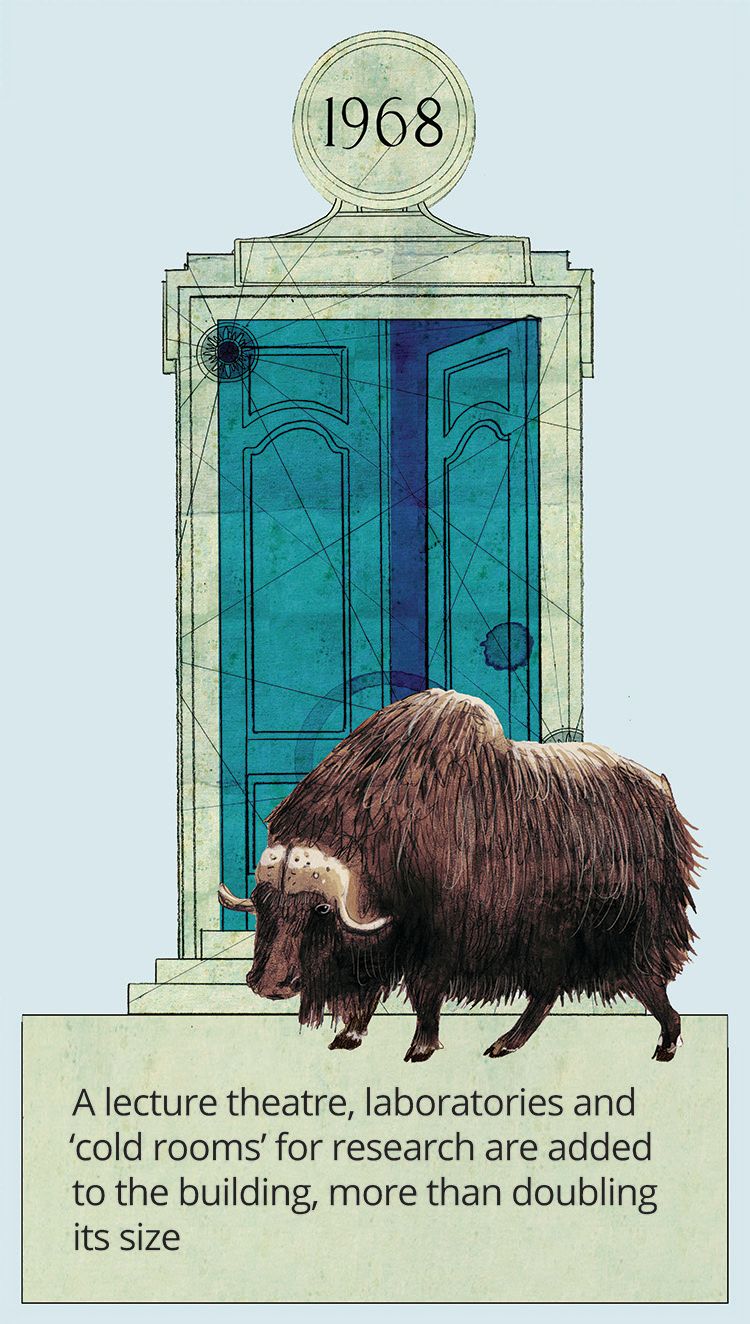
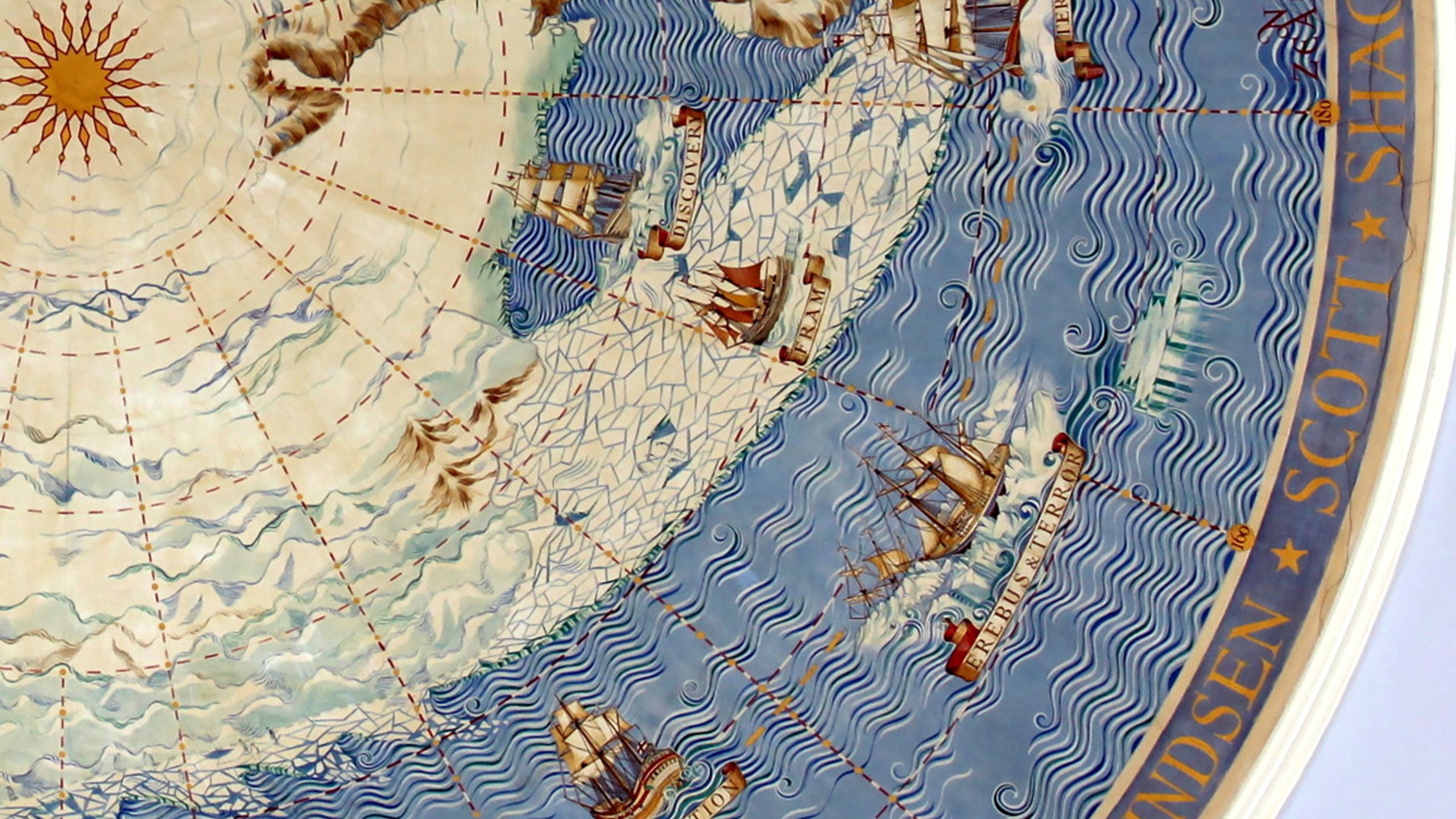
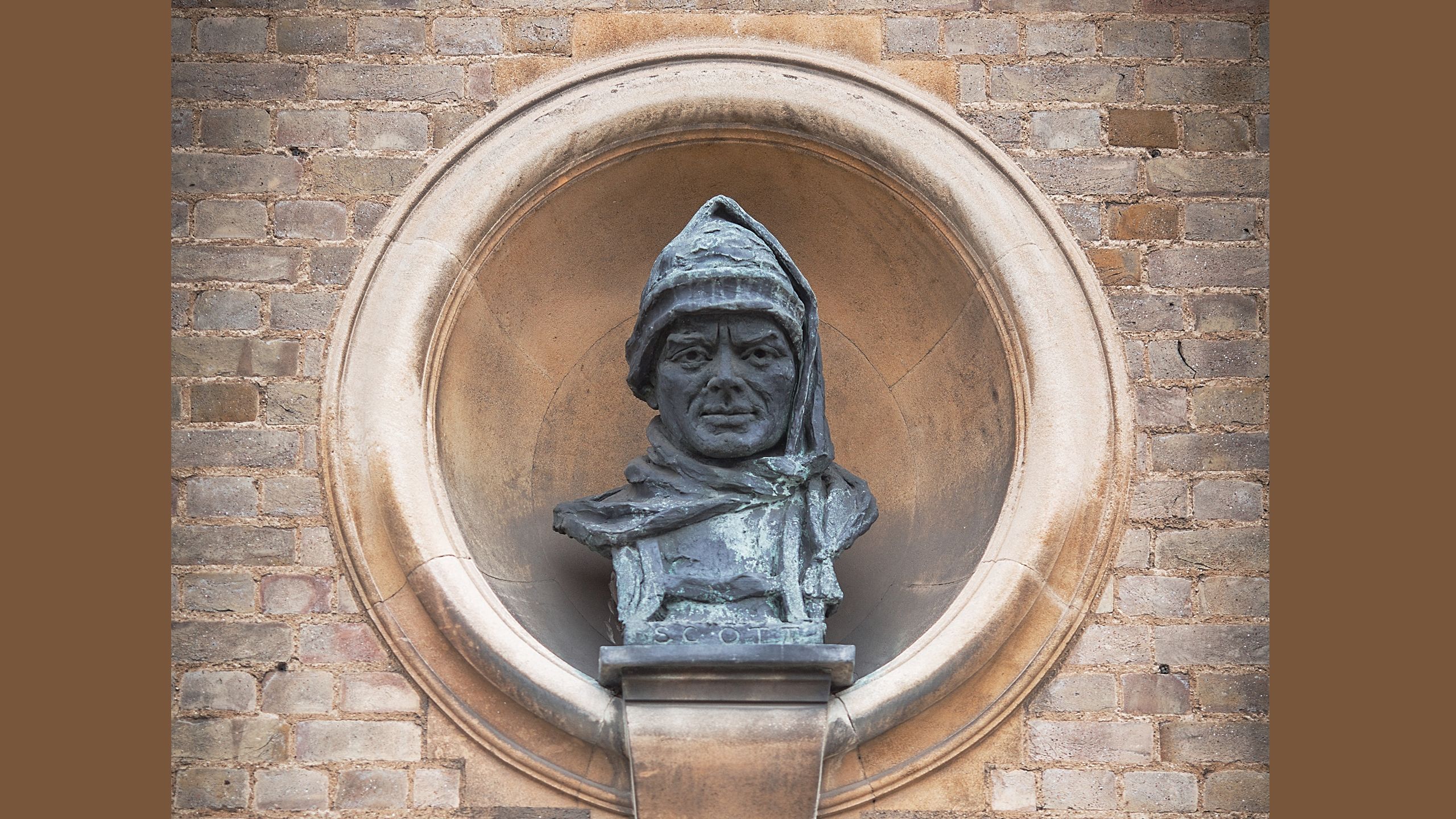
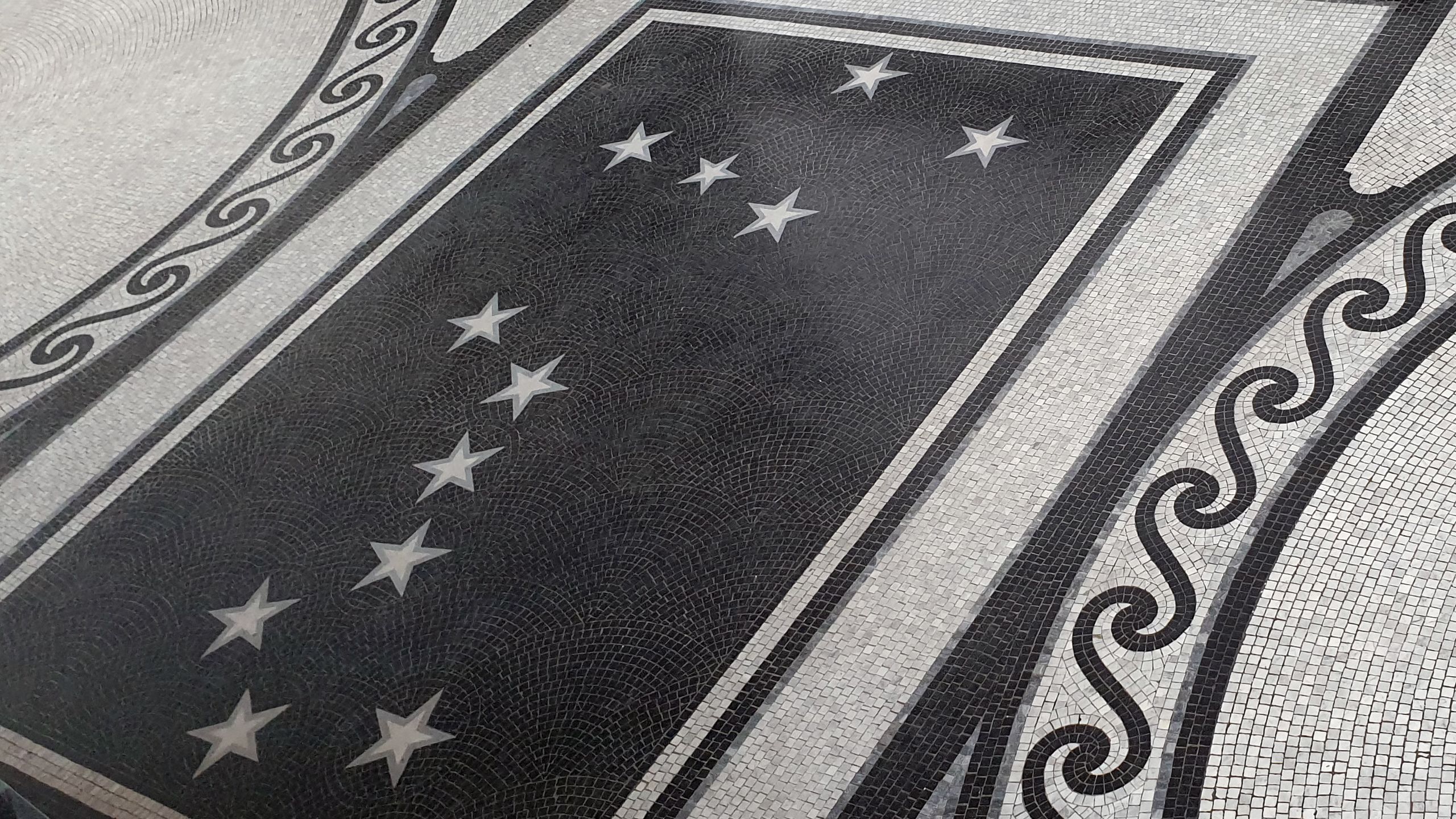

Detail from the Antarctic ceiling mural in the memorial hall of the Scott Polar Research Institute. Image copyright Scott Polar Research Institute, University of Cambridge.
Detail from the Antarctic ceiling mural in the memorial hall of the Scott Polar Research Institute. Image copyright Scott Polar Research Institute, University of Cambridge.

Bust of Captain Scott on the front of the Scott Polar Research Institute, cast from a sculpture by his widow Kathleen. Photographer: Martin Bond.
Bust of Captain Scott on the front of the Scott Polar Research Institute, cast from a sculpture by his widow Kathleen. Photographer: Martin Bond.

The starry mosaic on the floor of the memorial hall shows the southern cross and the great bear, the two polar constellations.
The starry mosaic on the floor of the memorial hall shows the southern cross and the great bear, the two polar constellations.
Early expeditions
The early years of SPRI, before the Second World War, are characterised by a number of expeditions to the polar regions.
In the early 1930s there had been no major British expeditions to the Antarctic for a decade. The government was concerned that this absence, alongside increasing international interest in the continent, would weaken British claims to Antarctic territories. To help strengthen these claims, the British Graham Land Expedition (BGLE), supported by SPRI and the Royal Geographical Society, ventured to Antarctica from 1934-37. The BGLE undertook scientific research and made a discovery which would change the way the world saw Antarctica for ever.
In 1933, while flying over Graham Land, American aviators Sir Hubert Wilkins and Lincoln Ellsworth reported seeing several ice channels. They believed the channels led from the Bellingshausen Sea to the Weddell Sea – making Graham Land an archipelago separate from mainland Antarctica. But when the BGLE undertook their own aerial and on-the-ground research in the area, they could not find any channels. Instead, the BGLE team realised that Graham Land was actually a large peninsula jutting out from the mainland – now called the Antarctic Peninsula. After their successful expedition, many BGLE members continued their careers at SPRI. Launcelot Fleming, the expedition’s geologist and chaplain, was Director from 1946-49, passing on the role to biologist Colin Bertram from 1949-56.
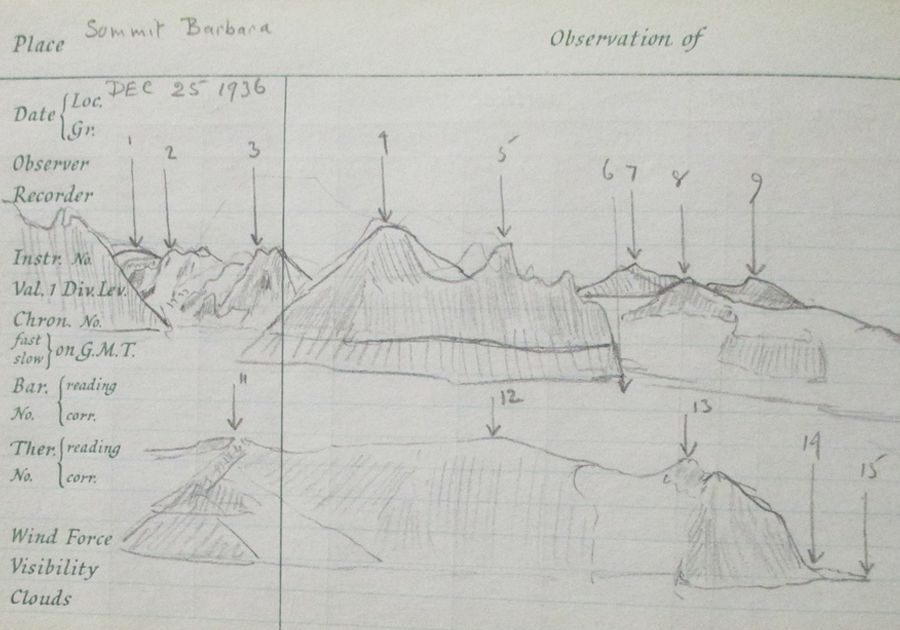
Detail from field notes taken on the British Graham Land Expedition. Scott Polar Research Institute Archive Collection, MS 1371/5/6.
Detail from field notes taken on the British Graham Land Expedition. Scott Polar Research Institute Archive Collection, MS 1371/5/6.
The new Institute was also there to support research in the Arctic, as well as the Antarctic. Gino Watkins made his name commanding the British Arctic Air Route expedition from 1930-31 which established a new flying route from North America to Britain over the Greenland Ice Sheet. But perhaps the most notable aspect of Watkins’ expeditions was not their scientific and surveying achievements, but his desire to learn from local Inuit communities.
The success of early European polar expeditions depended on the provisions that they could carry. Watkins understood that hunting could relieve the burden of transporting months’, or even years’ worth of food. He trained with Inuit hunters, learning to stalk seals silently from a kayak. By his final expedition in 1932, he was so practiced in Inuit hunting techniques that he only took a little oatmeal and sugar with him from England. Watkins’ deep-seated respect for Inuit technologies and ways of life was fairly unusual in the early 20th century but was vitally important to his success. He had learned the lessons of his western predecessors at SPRI but added to their teachings with the traditional knowledge of the Inuit.
Unfortunately, Gino Watkins was not immune to the dangers of the Arctic and, during his East Greenland Expedition 1932-33, he went out to hunt seals and never returned. His drifting kayak was later recovered, but Watkins was never seen again.
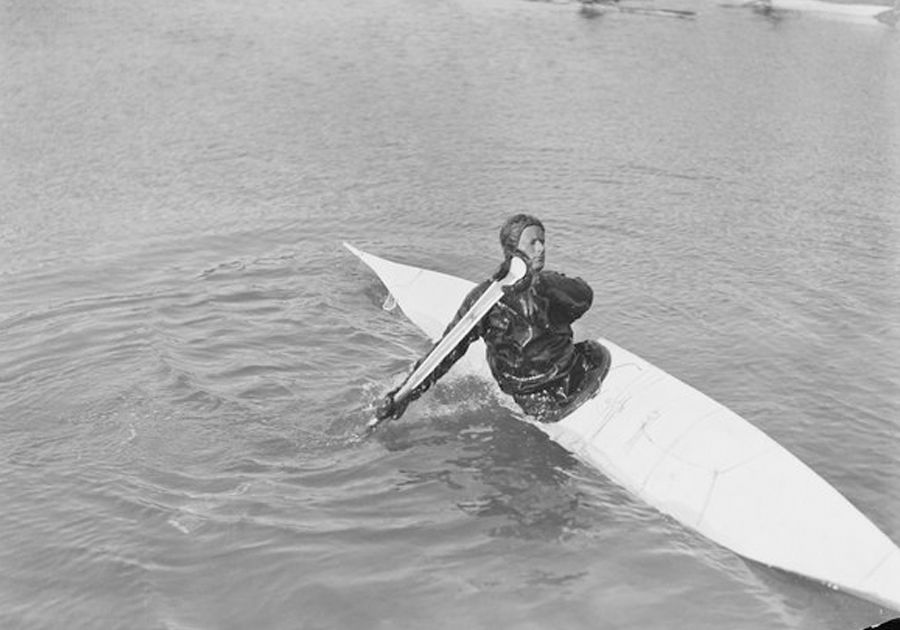
Gino Watkins about to roll his kayak, during the British Arctic Air Route Expedition 1930-31. Image copyright Scott Polar Research Institute, University of Cambridge. P48/16/4.
Gino Watkins about to roll his kayak, during the British Arctic Air Route Expedition 1930-31. Image copyright Scott Polar Research Institute, University of Cambridge. P48/16/4.
People and places
SPRI is home to an academic community which includes social scientists with expertise spanning the circumpolar North. But the first research positions dedicated to the study of northern cultures and communities were not created until the late 1940s when John Elbo was appointed Assistant in Scandinavian studies and Terence Armstrong became a fellow in Soviet Arctic studies. Elbo and Armstrong travelled extensively in the Arctic, forming connections with people as they learned about their ways of life. John Elbo sadly died of natural causes aged 31, but Terence Armstrong went on to develop a strong basis of social scientific enquiry and scholarship within the Institute. A fluent Russian speaker, Armstrong’s contacts led to exchange agreements with academies and libraries and it is largely thanks to him that the SPRI library holds an exceptional collection of some 25,000 Russian books, pamphlets and other material.
In more recent times, the Institute has come to recognise the importance of the self-determination of indigenous communities. Students from across the circumpolar North have come to SPRI to study the polar regions through a variety of disciplines, and the Institute has played host to visiting indigenous artists whose perspectives on the Institute’s collections have been invaluable.
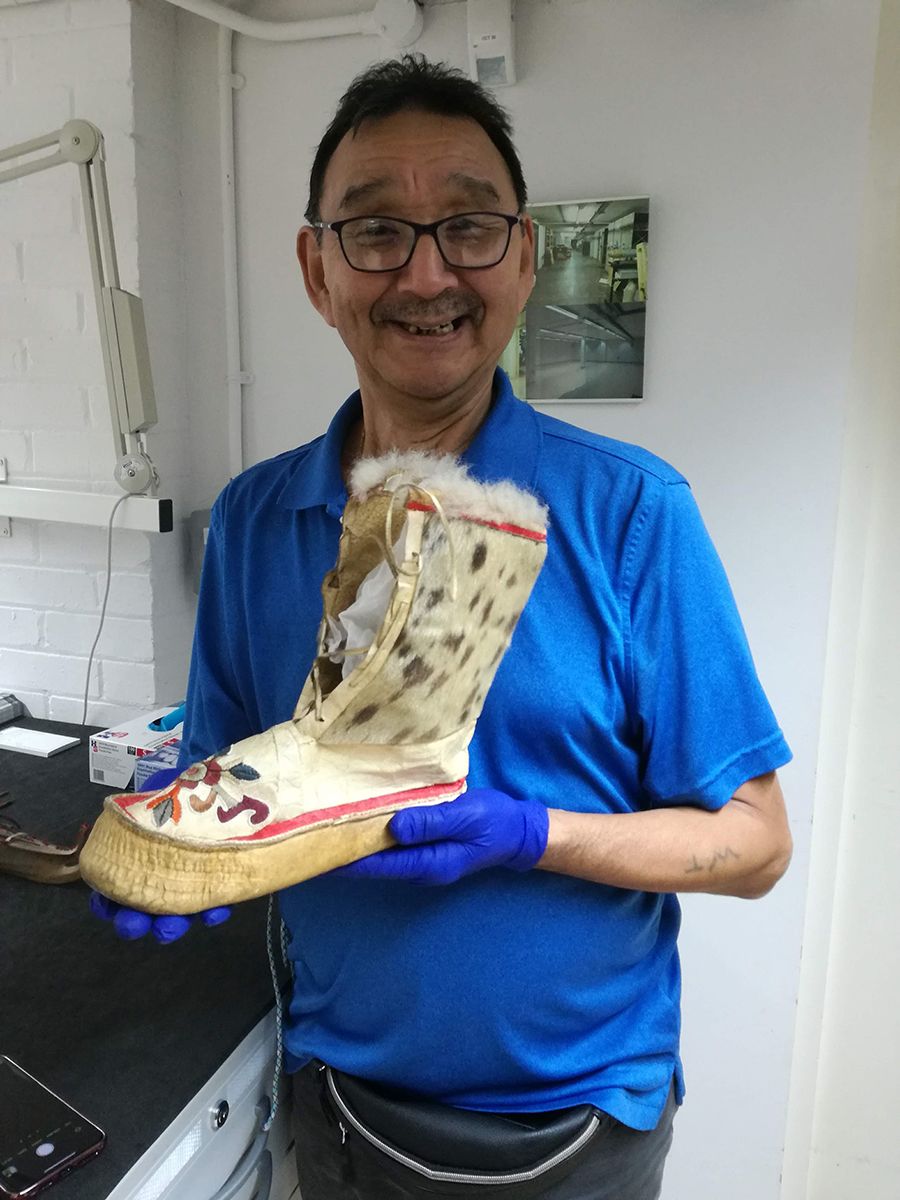
At the end of 2019, SPRI Welcomed Iñupiaq artist Willy Topcock to Cambridge.
At the end of 2019, SPRI Welcomed Iñupiaq artist Willy Topcock to Cambridge.
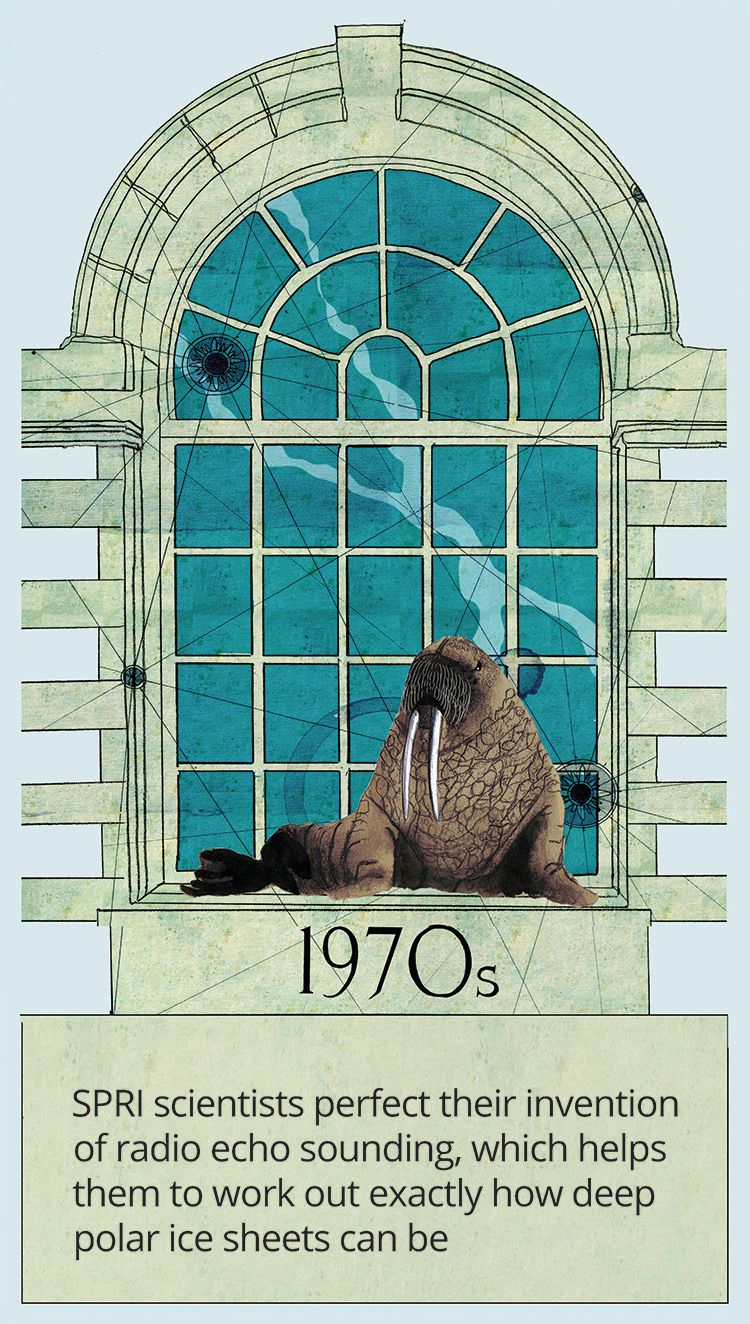
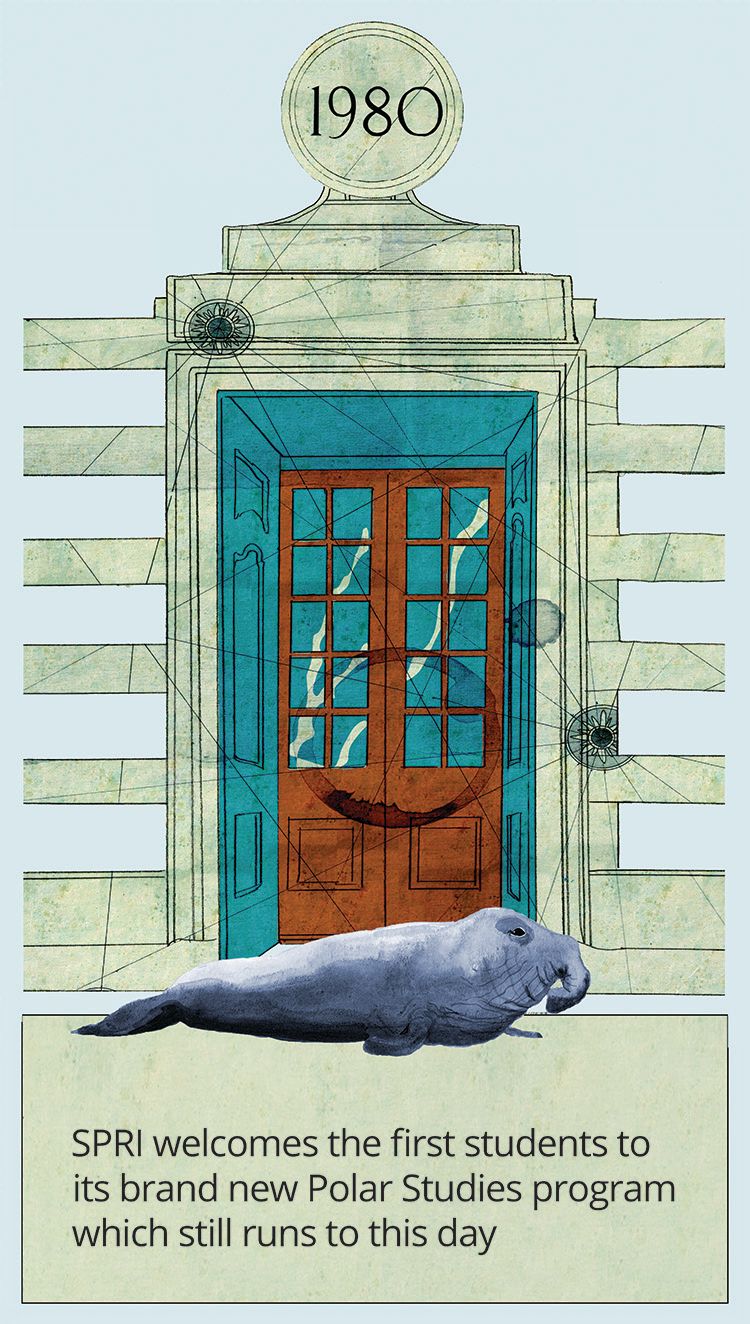
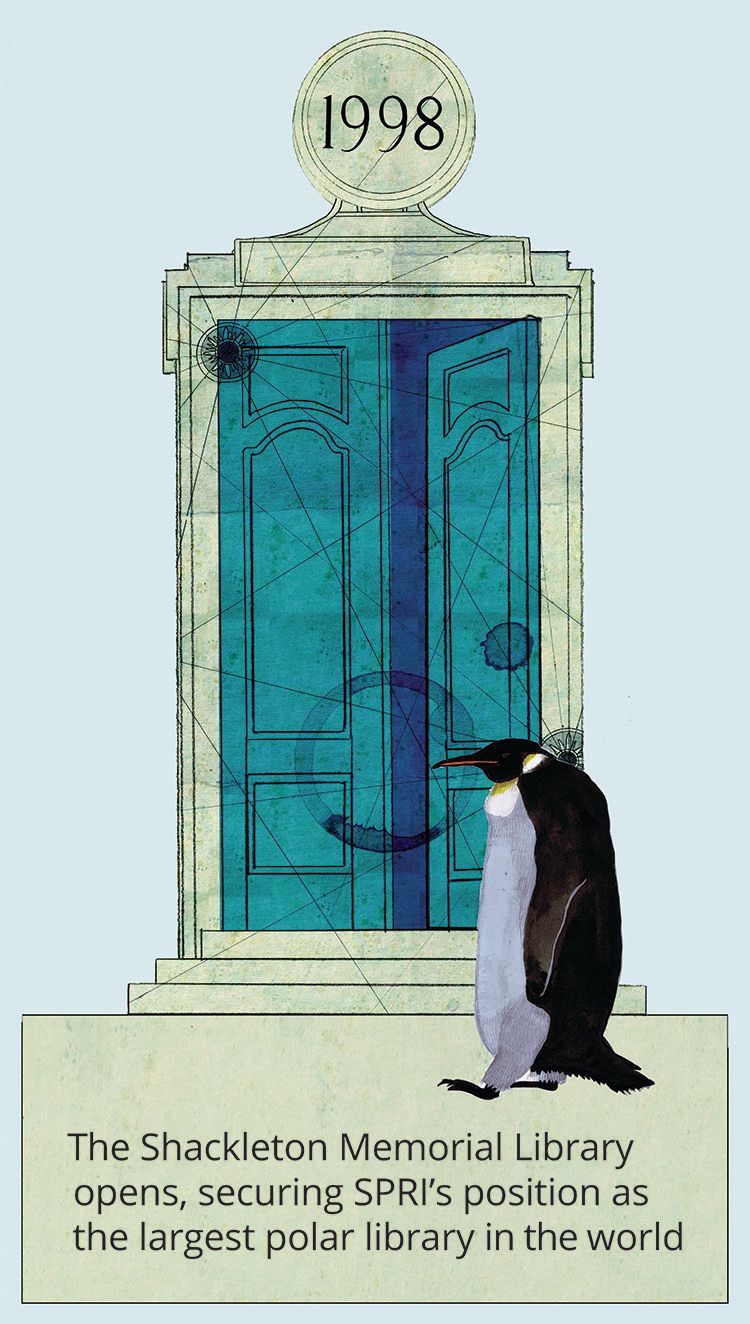
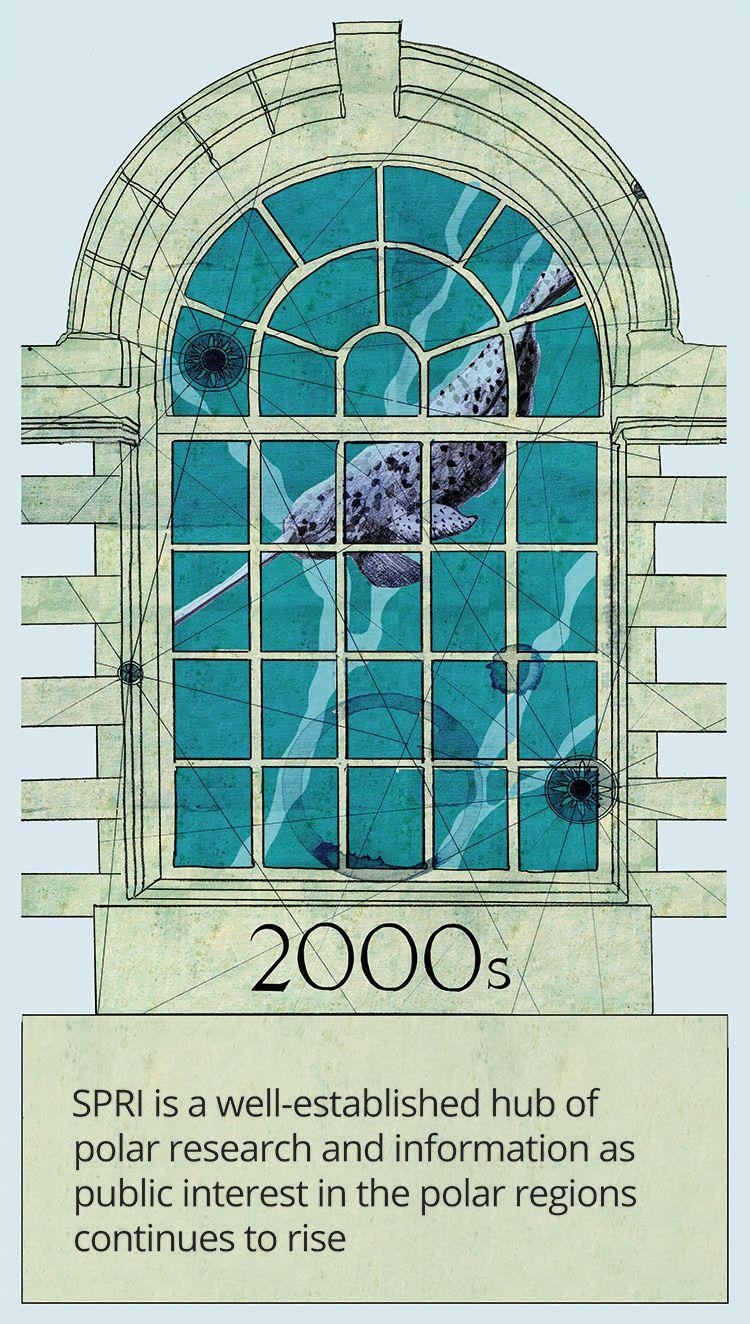
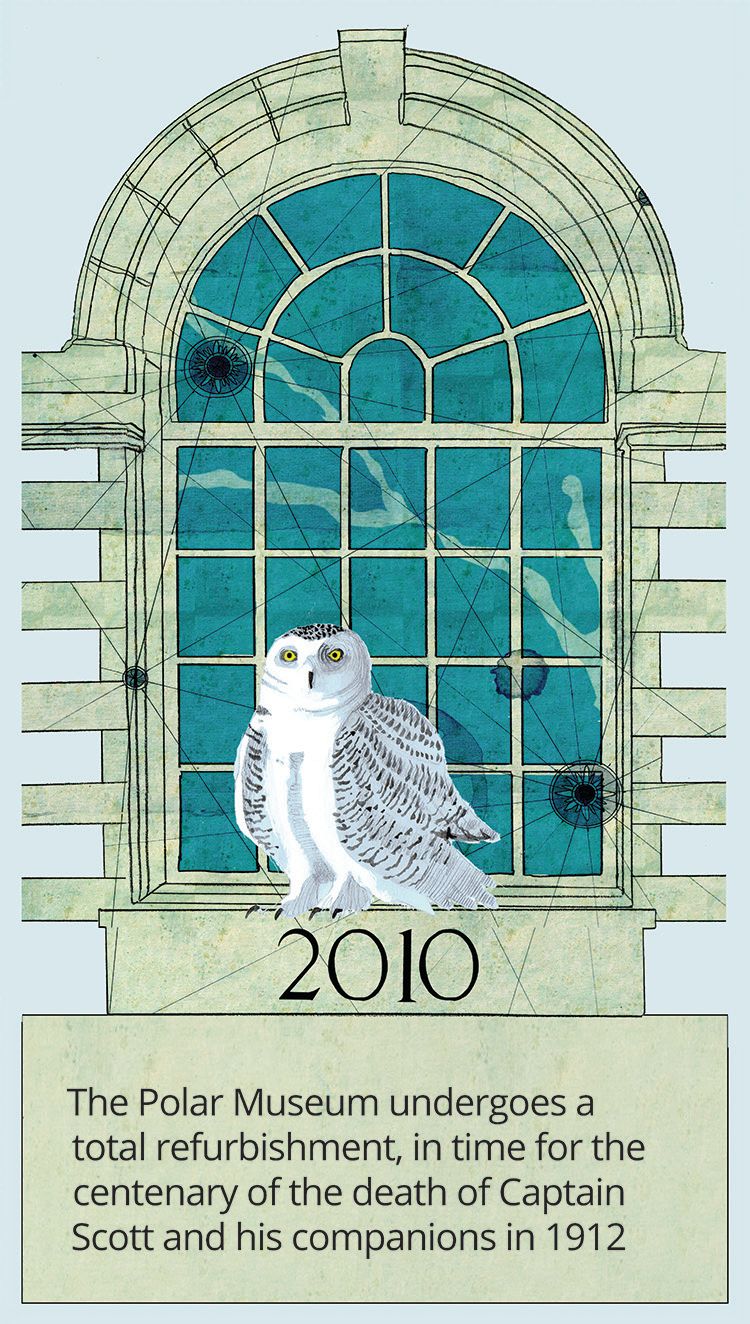


War and peace
During the Second World War, SPRI became an important centre for research to provide essential background information for the war effort in the Arctic. Work began on identifying suitable clothing and equipment to contribute to geographical handbooks for military personnel stationed in the Arctic.
One of those researchers was Brian Birley Roberts, who spent the early war years engaged in Arctic warfare research, before taking up a role at the Foreign and Commonwealth Office. He split his time between the two organisations for many years, and was very influential in the drafting of the Antarctic Treaty.
Signed in 1959, the Antarctic Treaty designates the Antarctic as a continent for peace and science. It suspends all claims to territory and supports international scientific cooperation and research. The Treaty is still in force today, having grown from 12 initial signatories, including the United Kingdom, to 52 signatories and a supporting system of related agreements.
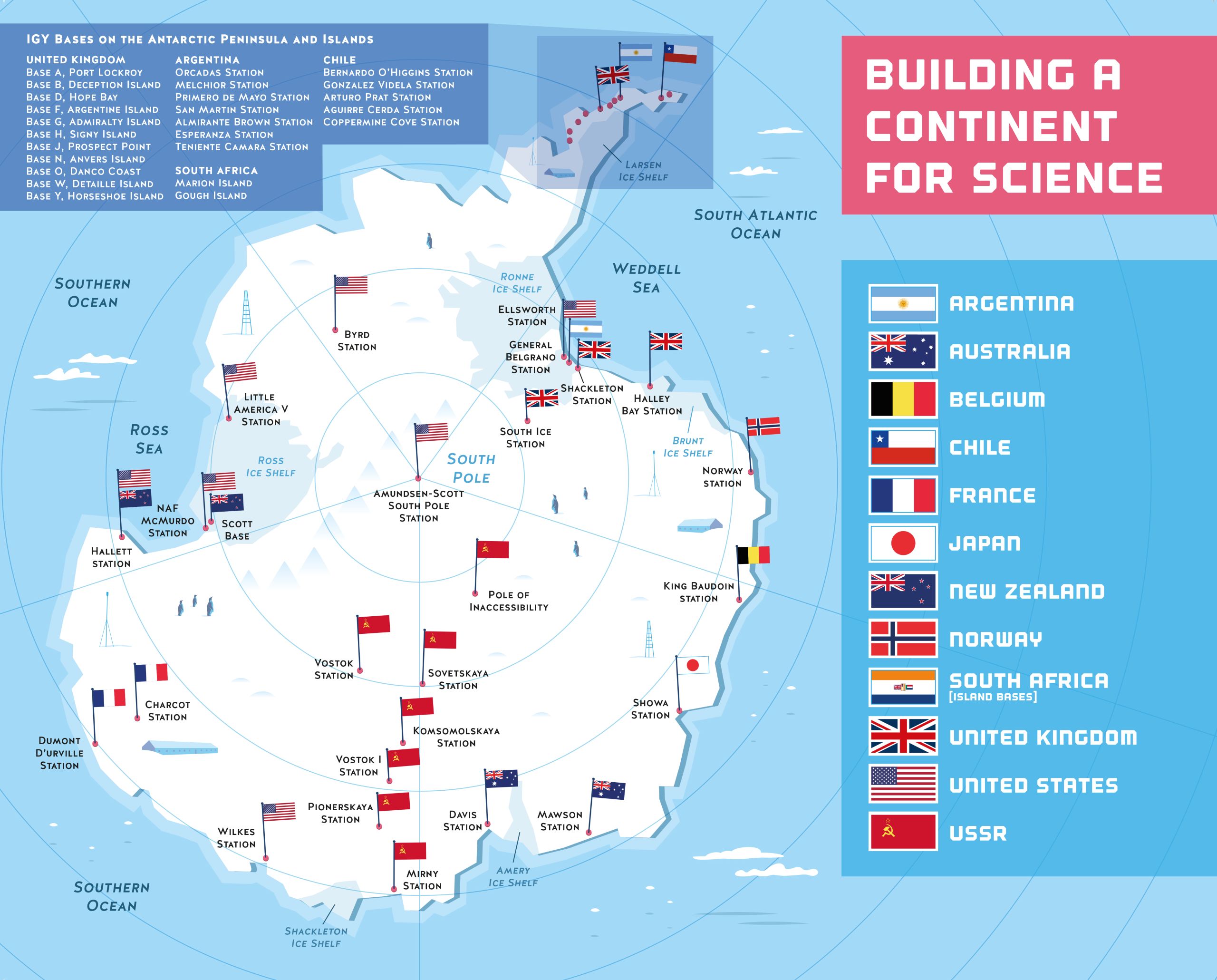
!957-8 was the International Geogphysical Year (IGY). For the year of science an agreement was made to suspend territorial claims in Antarctica in order to allow freedom of scientific enquiry. This paved the way for the Antarctic Treaty. The map shows the research bases in Antarctica during the IGY. Illustration: Tom Woolley Illustration/Scott Polar Research Institute, University of Cambridge
!957-8 was the International Geogphysical Year (IGY). For the year of science an agreement was made to suspend territorial claims in Antarctica in order to allow freedom of scientific enquiry. This paved the way for the Antarctic Treaty. The map shows the research bases in Antarctica during the IGY. Illustration: Tom Woolley Illustration/Scott Polar Research Institute, University of Cambridge
Objects, maps and books
The Scott Polar Research Institute (SPRI) has always been a place where polar researchers and explorers can come together to discuss their work and analyse their findings. To help with this, a ‘teaching collection’ of objects was formed. Polar explorers donated old kit and equipment to help prepare the next generation for their expeditions and research. Explorers’ widows and families gave treasured mementos and personal items, seeing the Institute as worthy of the memory of their loved ones. Arctic anthropologists like Ethel John Lindgren donated objects collected during field work to illustrate the cultures they encountered. This allowed indigenous responses to the challenge of life in extreme environments to be studied and committed to memory. After all, who better to learn from than the people who have survived and thrived in the north for millennia?
In the beginning, only Debenham’s assistant Miss Frances Drake catalogued the donated equipment, objects, maps and books – organising valuable collections for research. Today, this responsibility falls to a whole team of trained archivists, librarians and museum professionals. Thanks to its contributors, the SPRI now has the most wide-ranging polar collection in the UK and it continues to inform students, explorers and members of the public.
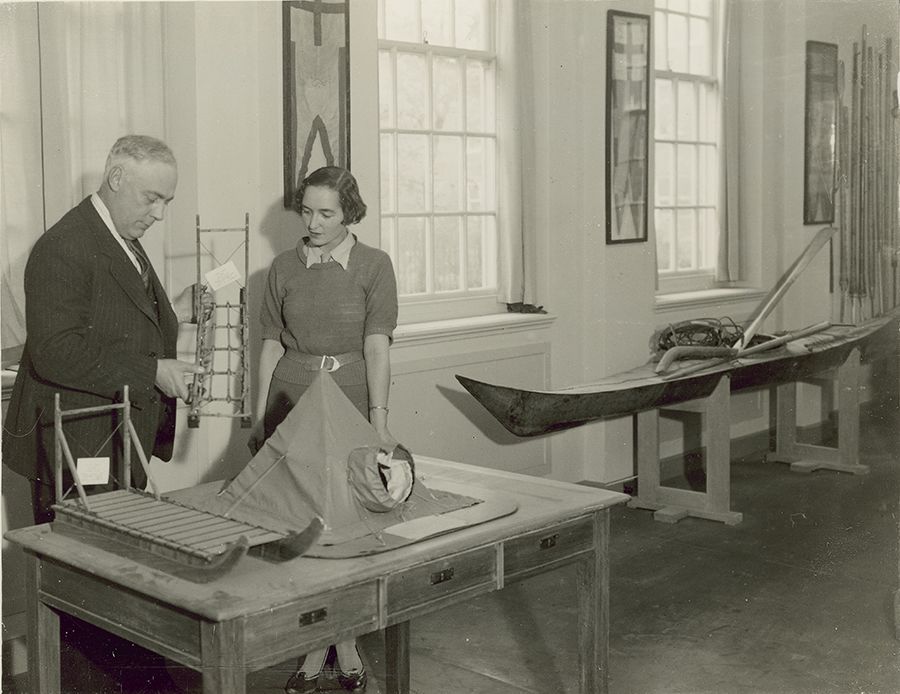
The Institute's first Director, Frank Debenham, accompanied by his assistant Elizabeth Creswick as he looks at some of the museum collections in 1934. P48/44/10
The Institute's first Director, Frank Debenham, accompanied by his assistant Elizabeth Creswick as he looks at some of the museum collections in 1934. P48/44/10
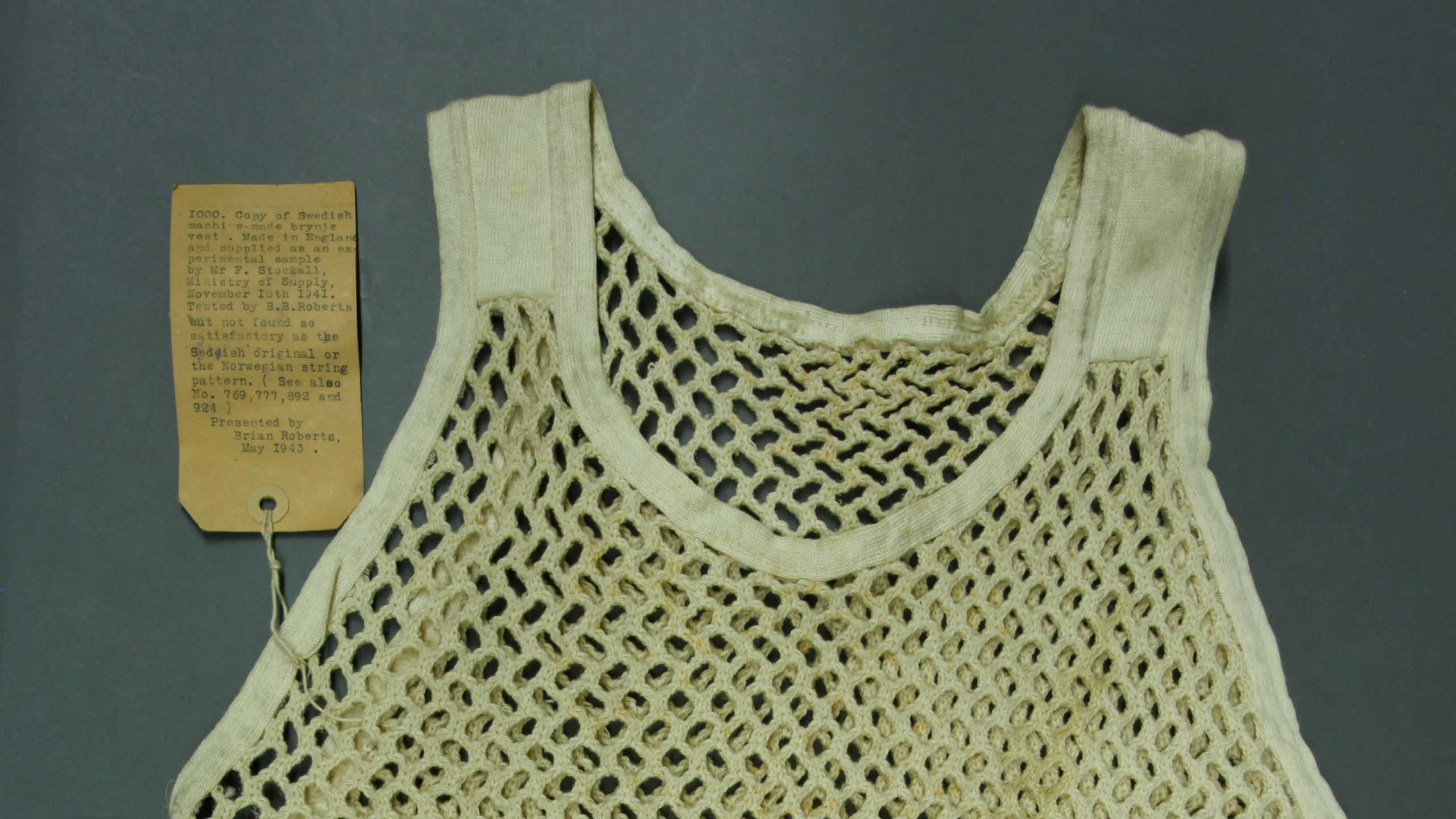
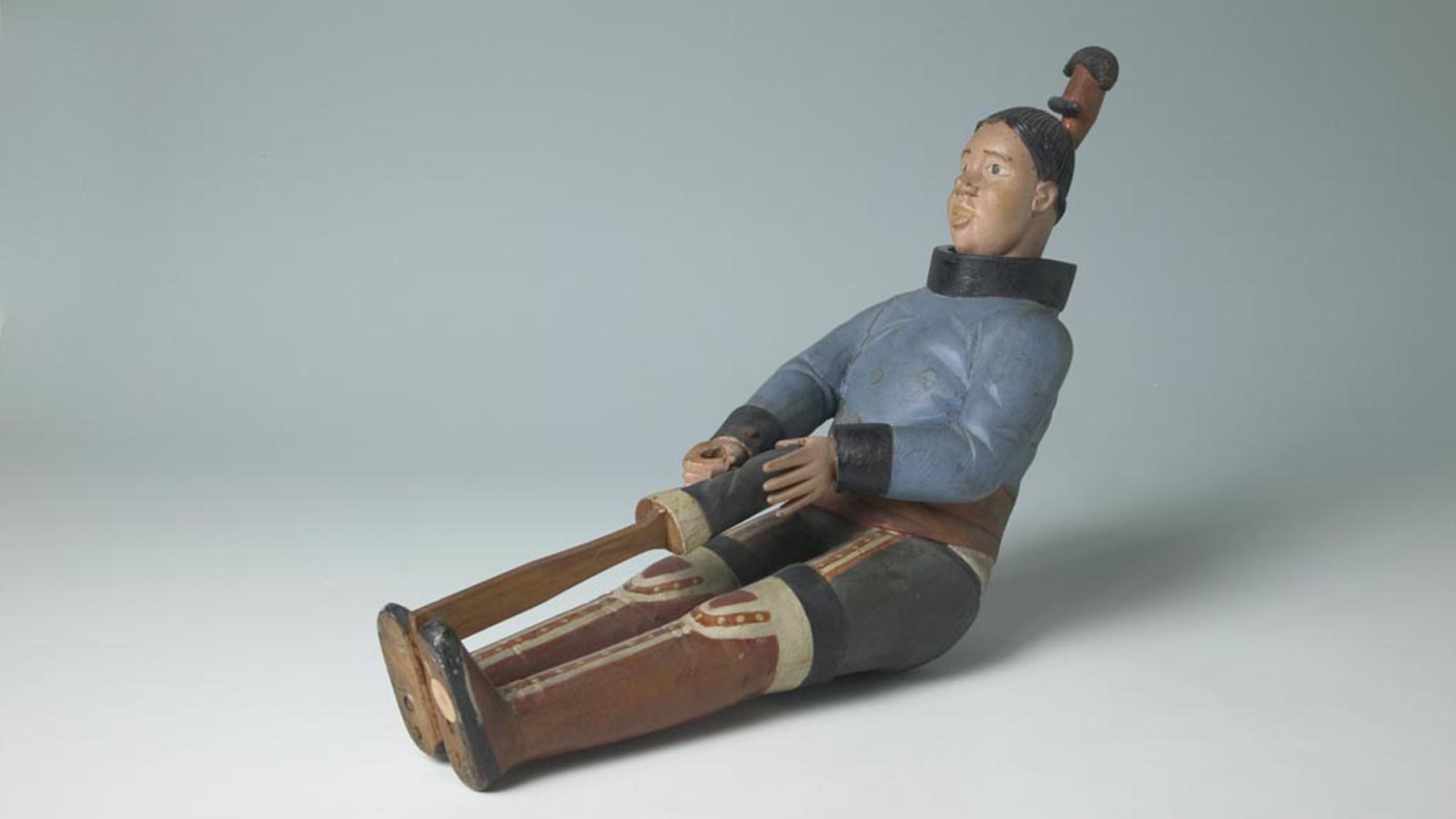
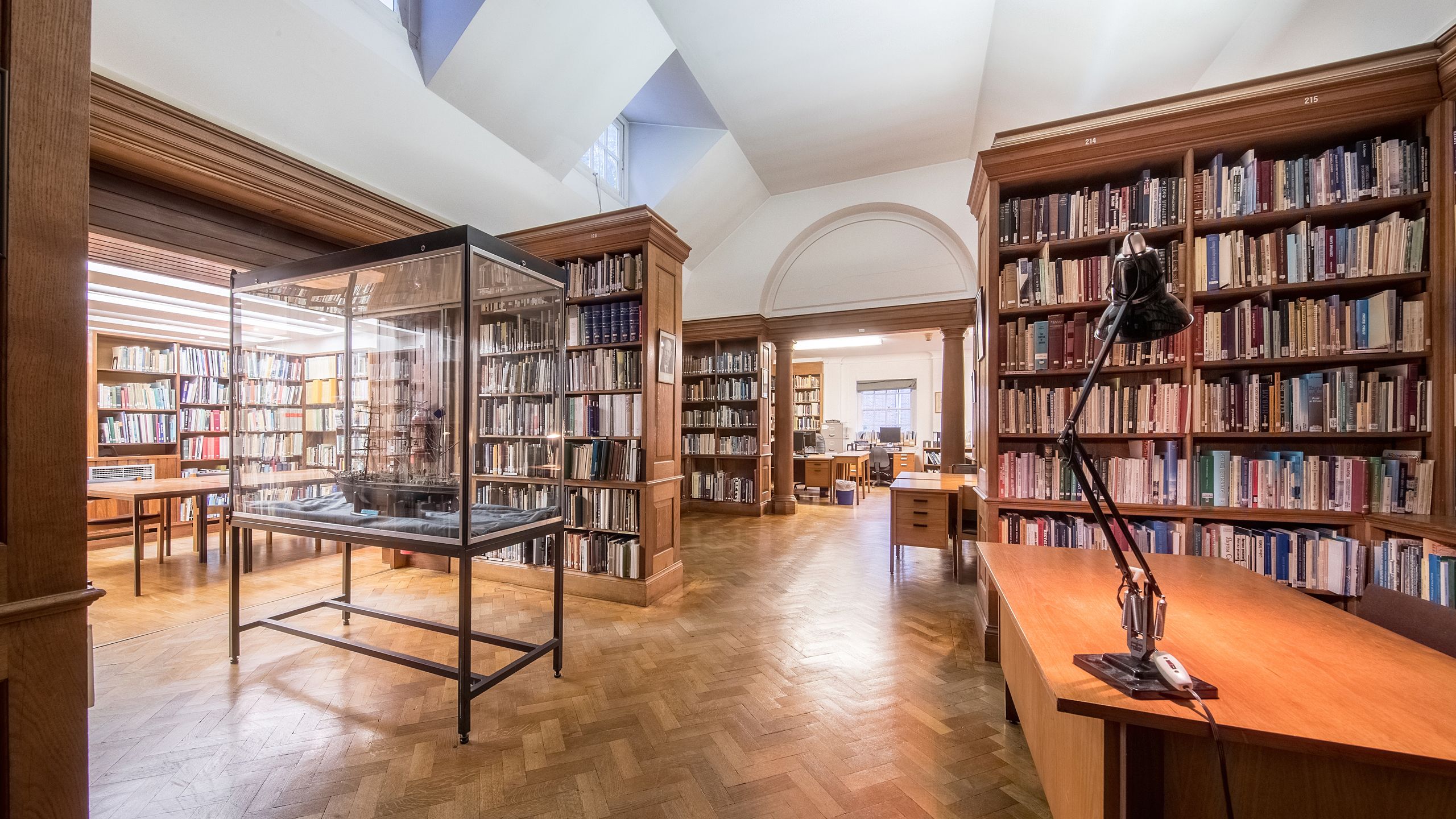

Swedish "Brynje" string vest. Experimental sample made by the British Ministry of Supply but not found satisfactory. Tested by Brian Roberts in 1941. Polar Museum N: 1000
Swedish "Brynje" string vest. Experimental sample made by the British Ministry of Supply but not found satisfactory. Tested by Brian Roberts in 1941. Polar Museum N: 1000

Model of inuit woman using a 'Kameo' to soften her sealskin boots. Carved from a single piece of wood by an Inuk near Sukkertoppen, West Greenland, collected by Arctic traveller Isobel Wylie Hutchison who spent time in Greenland in the 1920s and 30s.
Model of inuit woman using a 'Kameo' to soften her sealskin boots. Carved from a single piece of wood by an Inuk near Sukkertoppen, West Greenland, collected by Arctic traveller Isobel Wylie Hutchison who spent time in Greenland in the 1920s and 30s.

The Institute's polar library was expanded in 1968, then again in 2008 with new additions to the SPRI building. Photograph: Martin Bond.
The Institute's polar library was expanded in 1968, then again in 2008 with new additions to the SPRI building. Photograph: Martin Bond.
Measuring ice
In some parts of Antarctica, the ice lies up to 4.7 km thick over the land. Elsewhere, ice conceals whole mountain ranges from view. We know what this hidden world underneath the ice looks like because of the work of Stan Evans, Gordon Robin, Charles Swithinbank and their research teams who pioneered the technique of ‘radio-echo sounding’ in the 1960s and 70s.
Ice and snow allow radio waves at certain frequencies to pass right through them, but they cannot pass through the bedrock below the ice, so an echo bounces back. The SPRI scientists invented a device which they mounted on an aeroplane to emit and receive radio waves. By measuring the time between the wave being emitted and the echo bouncing back to the receiver, they could work out the depth of the ice they were flying over. Working with the US National Science Foundation, and later the Technical University of Denmark, from 1967-79 SPRI scientists revealed much of the buried landscape of Antarctica using this method. Radio-echo sounding continues to be important today, as understanding the shape of the bedrock, and consequently the flow of ice into the sea, helps to map the effects of climate change on the Antarctic continent.



Today the Scott Polar Research Institute continues in its dual role as national memorial to Captain Scott and the men who tragically died alongside him in Antarctica, and a vibrant centre for research into all aspects of the Arctic and Antarctic.
As part of the University of Cambridge, where it is a sub-department of the Department of Geography, the Institute is an important part of the intellectual life of the University. It also maintains strong links with colleagues in the British Antarctic Survey, which moved its headquarters to Cambridge in 1975, the Foreign and Commonwealth Office, the International Glaciological Society, the UK Antarctic Heritage Trust and across the polar research world. Its Polar Museum was totally refurbished in 2010 and is visited by around 50,000 people in a typical year, while the library, archive and picture library care for unique research collections that continue to be accessed by researchers from all over the world.
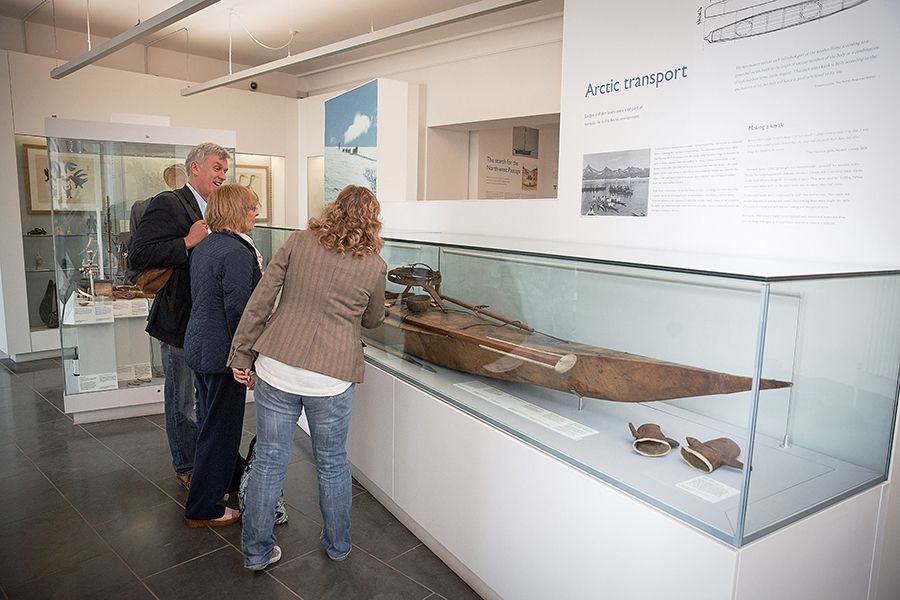
Visitors in the Polar Museum. Photograph: Martin Bond.
Visitors in the Polar Museum. Photograph: Martin Bond.
The work of the Institute continues to be vital as we observe unprecedented changes in the polar regions due to environmental change and globalisation. Watch the videos below to hear from some of our researchers about their important work.


Julian Dowdeswell, Director of SPRI and Professor of Physical Geography, is a glaciologist. In this video he tells us what that means, and why it is important.
PhD candidate Morgan Seag describes her reach into the history of science, environmental history and history of gender in Antarctica. She's interested in how and why women came to work in Antarctic science in the twentieth century.
Dr Richard Powell is Reader in Arctic Studies, and also leads a research project called Arctic Cultures: Sites of Collection in the Formation of the European and American Northlands'. Richard is joined by four researchers on the Arctic Cultures project, Dr John Woitkowitz (pictured), Dr Nanna Kaalund, Dr Johanne Bruun, and Dr Peter Martin with the support of project co-ordinator Jenny Dunstall.
In this video Richard explains more about his work and the Arctic Cultures project.
Dr Poul Christofferson is a Reader in Glaciology at the Institute. In his work he studies glaciers in Greenland and how they flow. In this video he describes why this work is important, and why SPRI's a good place to do it.
